New York V (Battleship No. 34)
1914-1946
The fifth U.S. Navy ship named for the 11th State of the Union, which ratified the Constitution on 26 July 1788.
V
(Battleship No. 34: displacement 27,000; length 573'; b. 95'3"; draft 28'6"; speed 21 knots; complement 1,042; armament 10 14-inch, 21 5-inch, 4 21-inch torpedo tubes; class New York)
The fifth New York (Battleship No. 34) was laid down on 11 September 1911 at Brooklyn, N.Y., by the New York Navy Yard; launched on 30 October 1912; sponsored by Miss Elsie Calder; and commissioned at her building yard on 15 April 1914, Capt. Thomas S. Rodgers in command.
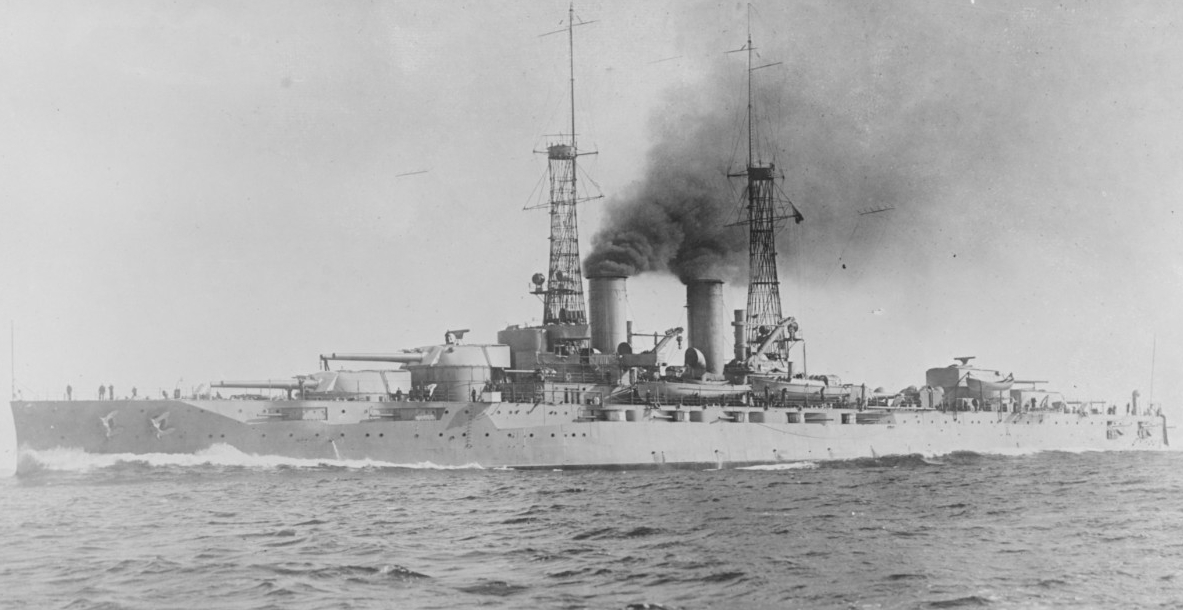
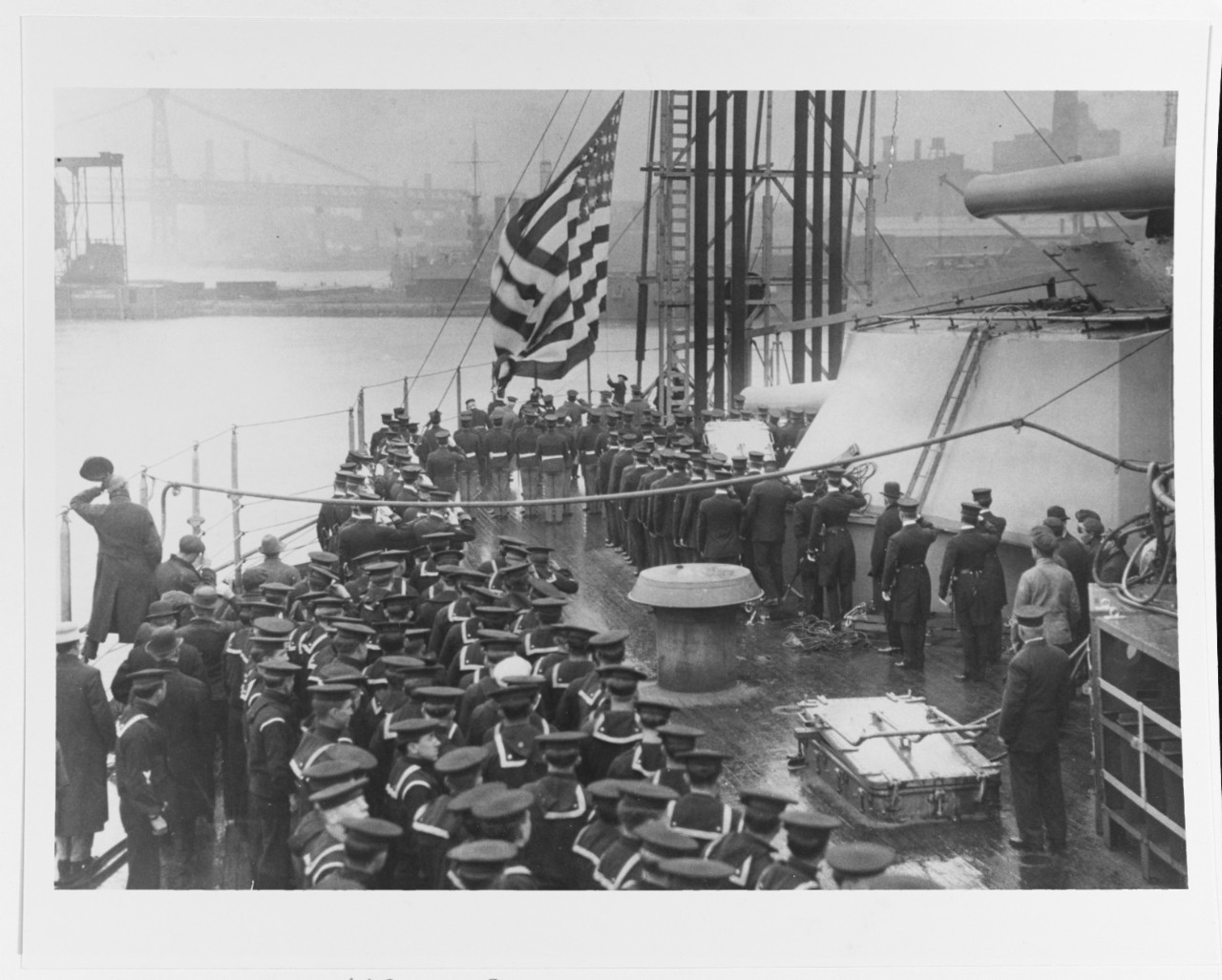
Ordered to Veracruz, Mexico, soon after commissioning, New York stood out of the Navy Yard on 26 April 1914, and shifted to Tompkinsville [Staten Island], N.Y., to embark her U.S. Marine guard before setting a course the same day for Newport, R.I. Arriving the next day, she was outfitted with her torpedoes and then departed for Hampton Roads, Va. Upon her arrival at the Virginia capes on the 28th, the battleship received funds for the fleet and then departed the same day for Veracruz, Mexico. Arriving on 4 May, New York served as the flagship for the Special Service Squadron, the force occupying and blockading Veracruz. The battleship continued to operate off Mexico through most of the summer. On 2 September, she was detached from the Special Service Squadron and re-assigned to the First Division, Atlantic Fleet. After shuttling between Galveston, Texas, and Veracruz (5 September-14 September), New York set a course for Hampton Roads on 17 September and arrived on 22 September.
After less than a week in port, New York operated out of Hampton Roads from 27 September and conducted training on the Southern Drill Grounds until 2 October, when she headed north for a return to Tompkinsville. Arriving on the 3rd, she then shifted to the New York Navy Yard and docked on 5 October. While undergoing yardwork, New York was detached from the First Division and assigned as the flagship, Atlantic Fleet when the Commander-in-Chief, Atlantic Fleet, transferred from Wyoming (Battleship No. 32) and broke his flag on board New York on 10 October. Four days later, the battleship undocked. She conducted a trial run to Rockland, Maine, on 17 October, and after a two-day port visit (18-20 October) returned to Tompkinsville on the 23rd. Returning to the New York Navy Yard (24 October-1 November), New York departed for Hampton Roads, arriving on the 2nd. She spent most of November conducting training on the Southern Drill Grounds and in the Hampton Roads vicinity. Departing the area on 30 November, she returned to the New York Navy Yard on 4 December. The ship remained at the yard through the beginning of the new year.
New York, while still at the yard, again received orders re-assigning her. These saw the transfer of the Commander-in-Chief, Atlantic Fleet back to Wyoming and her re-assignment to the First Division on 9 January 1915. A week later, on 16 January, she stood out of the New York Navy Yard, passed the Scotland light vessel, and steamed southward for the Southern Drill Grounds. After two days conducting training (19-21 January), New York arrived at Guantanamo Bay, Cuba for the annual winter gunnery training and tactical exercises in the Caribbean. During this training cycle, the flagship of the First Division, Atlantic Fleet transferred from Oklahoma (Battleship No. 37) to New York on 31 March. The flagship departed Guantanamo on 2 April and returned with the division to Hampton Roads. Over the next month, New York operated from Hampton Roads on the Southern Drill Grounds until 7 May when she steamed to New York and anchored in the North River the next day. After conducting maneuvers (18-26 May), New York visited Tompkinsville (26-27 May) and then entered the New York Navy Yard later on the 27th. While at the yard, New York received orders transferring the First Division flag to Arkansas (Battleship No. 33) on 24 June.
New York, after more than three months in the yard, got underway and went to sea on 1 September 1915. Arriving at Hampton Roads on 2 September, she operated in the vicinity of the Virginia capes into October. Getting underway for maneuvers on 4 October, New York arrived at Newport on the 9th. After visiting until 9 October, the battleship returned to Hampton Roads on the 16th. Through 12 December New York operated from both Hampton Roads and New York, until standing into the New York Navy Yard on that day. She would remain there through the holiday season.
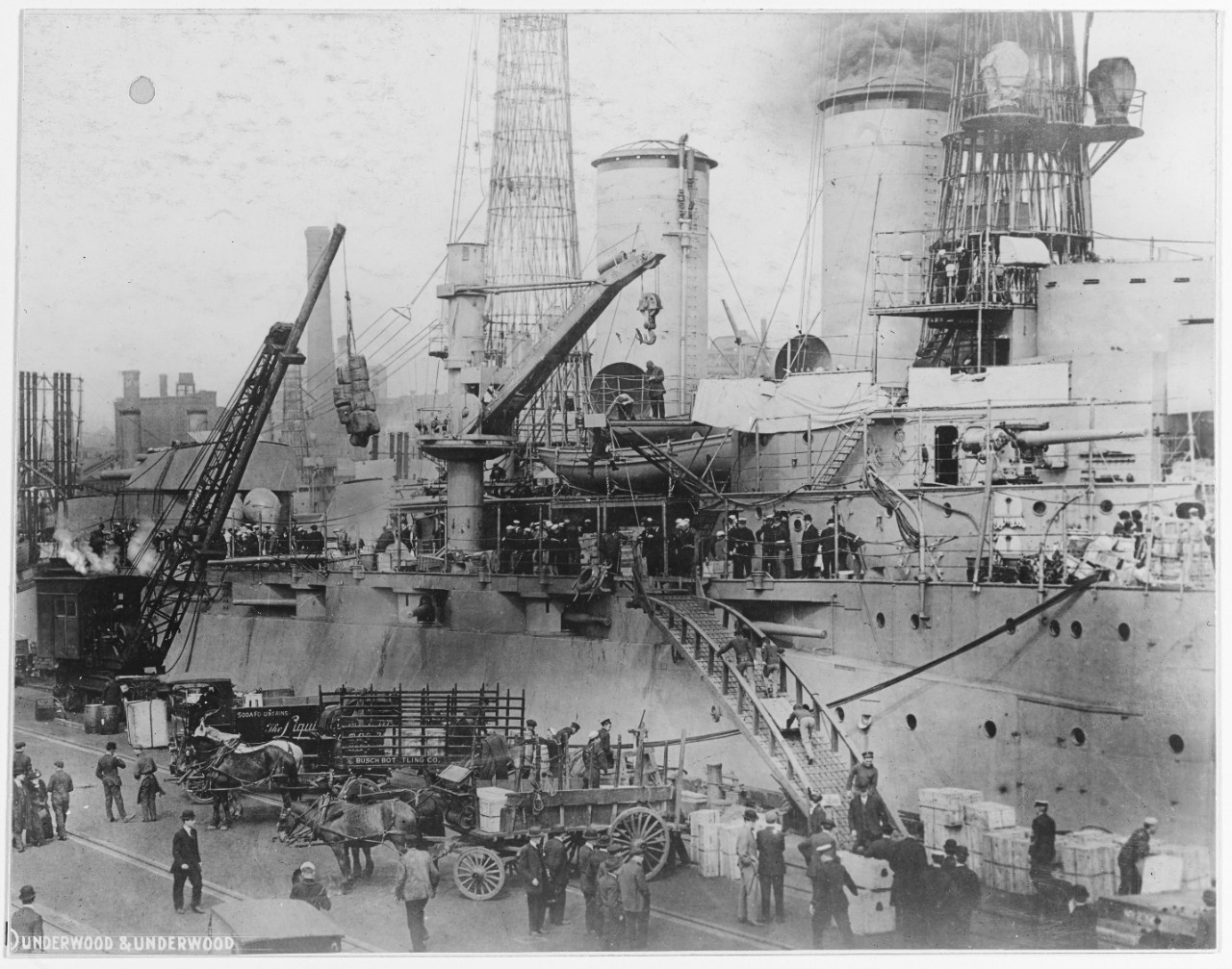
On 3 January 1916, New York departed the New York Navy Yard and shifted to Tompkinsville. She remained there three days before getting underway for maneuvers on the 6th. She then headed to Culebra, P.R. Arriving on the 16th, she spent the ensuing months conducting the annual cycle of gunnery and tactical training in Caribbean waters. During the course of this training she did make a visit to Fort Morgan, Ala. (12-16 March). Departing Guantanamo on 10 April, New York stood in to and docked at the New York Navy Yard on the 17th. She remained there until 21 May. During this yard period, she received orders re-assigning her on 15 May.
Now a unit in the Sixth Division, Atlantic Fleet, New York undocked and got underway on 21 May 1916. Arriving at Boston the next day, the battleship spent the succeeding summer months operating off the coast of New England. Departing Newport on 30 August, New York stood into Hampton Roads on 1 September. The warship operated from there before docking at the New York Navy Yard on 2 October. After completing her yard work on 12 November, she rotated between Hampton Roads and New York until 19 December when she docked at the New York Navy Yard after a brief stop at Tompkinsville. As she had in previous years, New York spent Christmas and New Year’s days at the New York Navy Yard.
New York got underway from the New York Navy Yard, via Tompkinsville, and steamed to the Caribbean. Arriving at Culebra on 15 January, she was to participate in the Fleet’s annual winter training exercises. As a result of Germany’s resumption of unrestricted submarine warfare on 1 February 1917, the United States severed diplomatic relations on 3 February 1917. This prompted the Navy to change the base of the Atlantic Fleet, under the command of Adm. Henry T. Mayo, from Guantanamo Bay, Cuba to Guacanayabo Bay, Cuba. The Fleet’s Battleship Force was under the command of Vice Adm. DeWitt Coffman. New York was still assigned to the Sixth Division along with Delaware (Battleship No. 28), Texas (Battleship No. 35), and Oklahoma under Rear Adm. Augustus F. Fechteler. While at Guacanayabo Bay, the Fleet completed the annual target practices and gunnery exercises as scheduled.
On 20 March 1917, the Fleet left Guacanayabo and returned to Guantanamo Bay the next day, 21 March. On 23 March, the Fleet departed Guantanamo Bay for Hampton Roads, Va., arriving on the 27th. The Fleet, on 3 April, left Hampton Roads and established a fleet base in the York River off Yorktown, Va. After the 6 April declaration of war against Germany, a submarine defense net was placed across the York River and New York and her fellow fleet units mobilized for war. Receiving recruits of various kinds, she began intensive training and gunnery practice, especially on submarines as targets. New York held rehearsals and conducted battle practice in the Chesapeake Bay and at sea with other vessels of the Atlantic Fleet through the end of June.
New York arrived at the New York Navy Yard on 5 July and remained there until 7 August. Shifting to Tompkinsville on the 7th, she departed the next day for the fleet anchorage at Yorktown, arriving on the 9th. Ten days later, she had shifted to the fleet anchorage of Port Jefferson, N.Y., in Long Island Sound. From mid-August through 1 October, New York operated in the waters around Long Island training for future combat operations. On 2 October, she was at the New York Navy Yard having three of her starboard propeller blades replaced. After undocking, she headed to sea and returned to the York River anchorage on the 6th. She remained in the Hampton Roads-York River area into November.
The Navy Department, on 12 November 1917, selected the coal-burners New York, Florida (Battleship No. 30), Wyoming, and Delaware (Battleship No. 28) to form Battleship Division Nine as reinforcement for the British Grand Fleet. The battleships were to be commanded by Rear Adm. Hugh Rodman. The next day the flag for Division Six, Battleship Force was transferred from New York to Utah (Battleship No. 31) and the flag for the Commander of Division Nine, Battleship Force was broken in New York. The battleship arrived at Tompkinsville on 15 November and the next day, she shifted to the New York Navy Yard to be fitted out for distant service. She remained at the yard until the 22nd, when she departed for Lynnhaven Roads, Va., arriving on the 23rd.
At 3:00 p.m. on 25 November 1917, Battleship Division Nine sailed from Lynnhaven Roads with Manley (Destroyer No. 74) in escort. While Manley was to join the convoy escort and patrol forces based at Base No. 6, Queenstown [Cobh], Ireland, Division Nine was bound for the Royal Navy’s Grand Fleet anchorage at Scapa Flow, Orkney Islands, Scotland, to serve under the command of Adm. Sir David Beatty, RN. The weather on the voyage was bad from the start, but worsened during the night of 30 November-1 December. Delaware and Florida lost contact with New York and Wyoming. New York took on over 250 tons of water in her chain locker and forward compartments and only the efforts of bailing lines for three days prevented the ship from foundering. Division Nine eventually re-consolidated at 7:00 a.m. on 7 December at Cape Wrath and continued on to Scapa Flow. With a hearty welcome from the crews of the ships of the Grand Fleet, the ships anchored at noon.
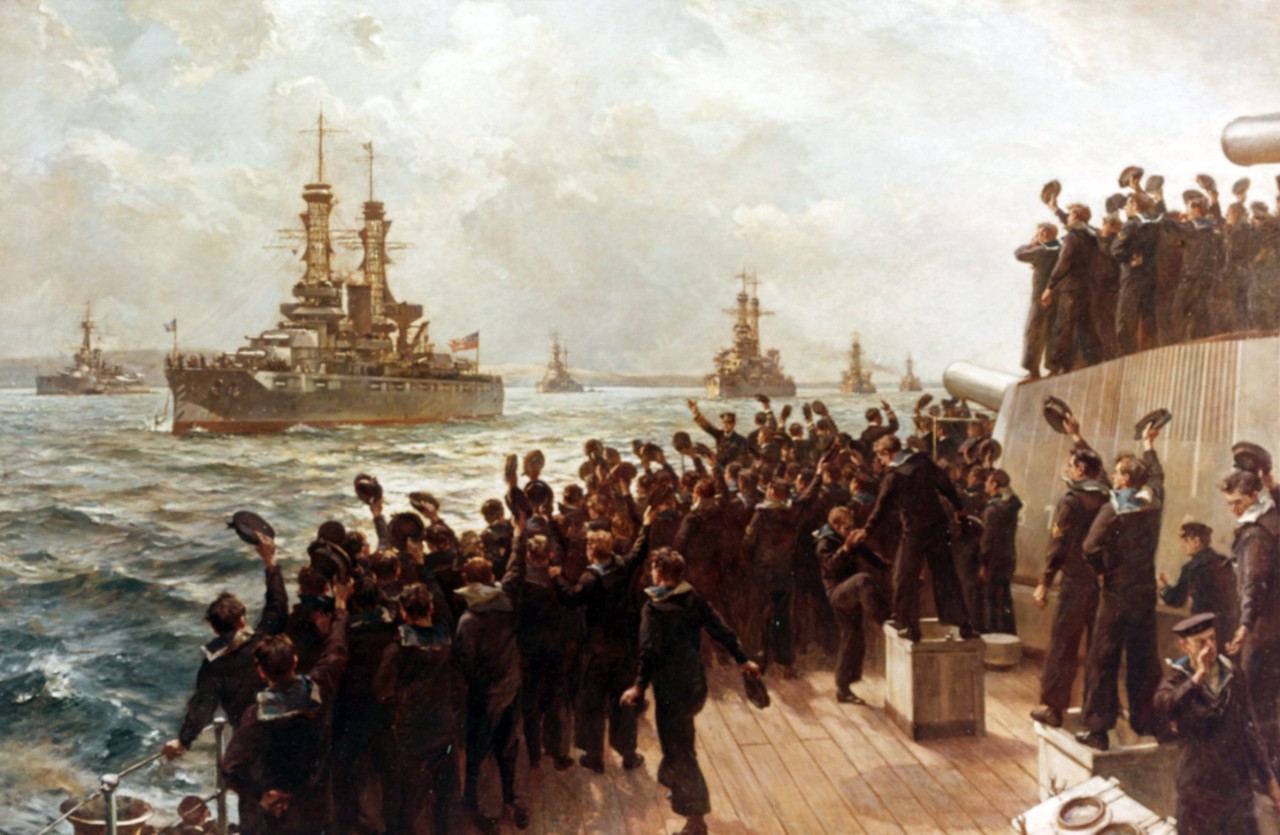
Under British command, Battleship Division Nine was re-designated the Sixth Battle Squadron and assigned a position in the fast wing of the Grand Fleet. The U.S. ships, however, needed time to learn and become adept with Royal Navy practices. Two areas of particular concern for Beatty were the state of U.S. communications and gunnery. Despite their confidence upon arrival, the relative disparity between the two navies and their relative capabilities became readily apparent, especially in light of the Britons’ three years of wartime experience. The realization of this was quite sobering for the Americans. As such, Rodman set his division to extensive training in order to integrate fully with the British. An example of this training included the Grand Fleet getting underway on 30 January 1918 to conduct maneuvers and tactical training as “opposing fleets” in the waters between Norway and Scapa Flow. The exercise concluded on 2 February and the fleet returned to its anchorage in the Orkneys.
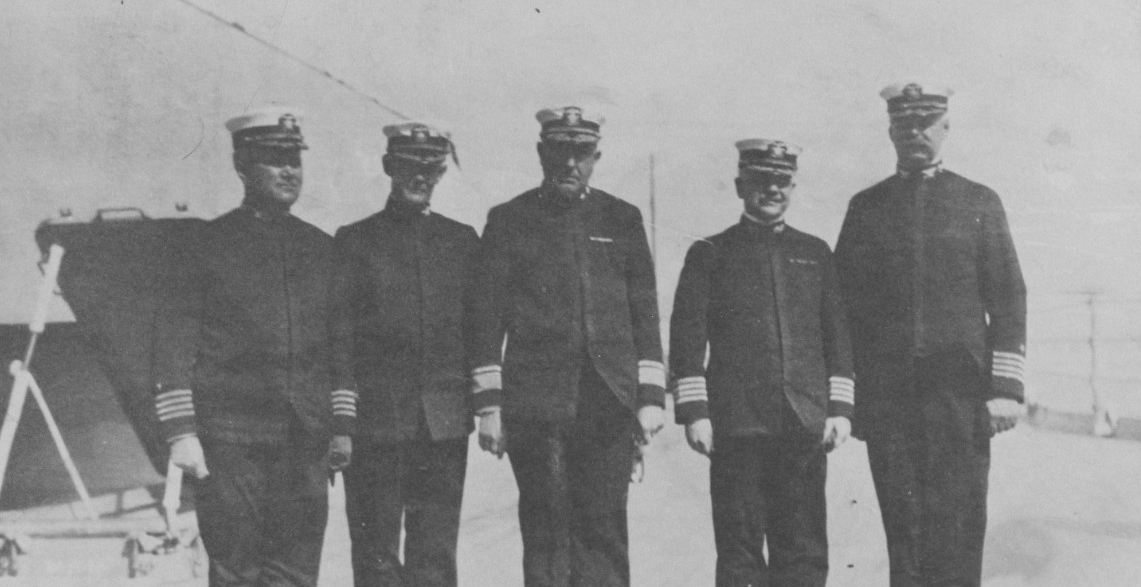
A few days later, on 6 February, the Sixth Battle Squadron weighed anchor and departed Scapa Flow for a convoy escort mission to neutral Norway, designated Operation Z6. The squadron was to cooperate with the Grand Fleet’s Third Light Cruiser Squadron; both were to operate in conjunction with their respective destroyer screens. Rear Adm. Rodman was placed in overall command, making this the first time that Royal Navy men-of-war served under a U.S. admiral. Having rendezvoused with the 30-ship convoy, OZ6, early on the 7th, the battleships and cruisers acted as a covering force, interspersing themselves between the merchant vessels and the German fleet. Though there firing of shots from a secondary battery prompting a response from the battleships, no enemy was found. The warships conducted their escorts to Norwegian territorial waters without further incident and released them to continue their voyage into port. The escorts hovered and awaited the arrival of the outbound HZ7 which was steaming westward from Selbiorns Fjord. At 1:22 p.m., New York hoisted the green submarine warning flag, but cancelled is shortly thereafter as the British destroyer, Valorous reported the supposed sighting as porpoises. Shortly thereafter, however, Florida and Delaware reported a submarine and maneuvered to avoid reported torpedoes. Despite this excitement, the convoy continued to be shepherded westward. The covering force parted company with the convoy around 5:30 p.m. As the merchantmen continued on into British ports, the battleships and cruisers steamed home, arriving at Scapa Flow around 4:00 a.m. the morning of the 10th. The next day, New York’s sister ship, Texas (Battleship No. 35) arrived, joining the Sixth Battle Squadron as the fifth unit. With the arrival of another battleship, Rodman continued to drill the squadron to improve its level of interoperability with the other units of the Grand Fleet.
The squadron was again called upon to escort a convoy to Norway. Getting underway with a screen of eight destroyers on 8 March 1918, the force rendezvoused with convoy OZ15 at 7:15 the next morning. They were also bolstered by the presence of the 2nd Light Cruiser Squadron steaming out of Rosyth, Scotland, on the Firth of Forth, with her destroyer screen from the 13th Flotilla. Unlike the preceding escort mission, the convoy steamed into heavy weather. Making slow progress and running behind schedule, the escorts parted company with the eastbound convoy 35 miles from Stavanger, Norway, in anticipation of escorting an outbound convoy. As the ships maneuvered, signals from New York ordering changes in course were missed due to heavy fog. Only quick responses in handling by individual ships, averted what would have been disastrous collisions. There were further incidences of miscommunication and ships becoming separated, but the convoy made it to Britain without loss and the battleships returned to Scapa Flow around 5:30 p.m. on 13 March. About a month later, in mid-April, the Grand Fleet relocated its anchorage to Rosyth.
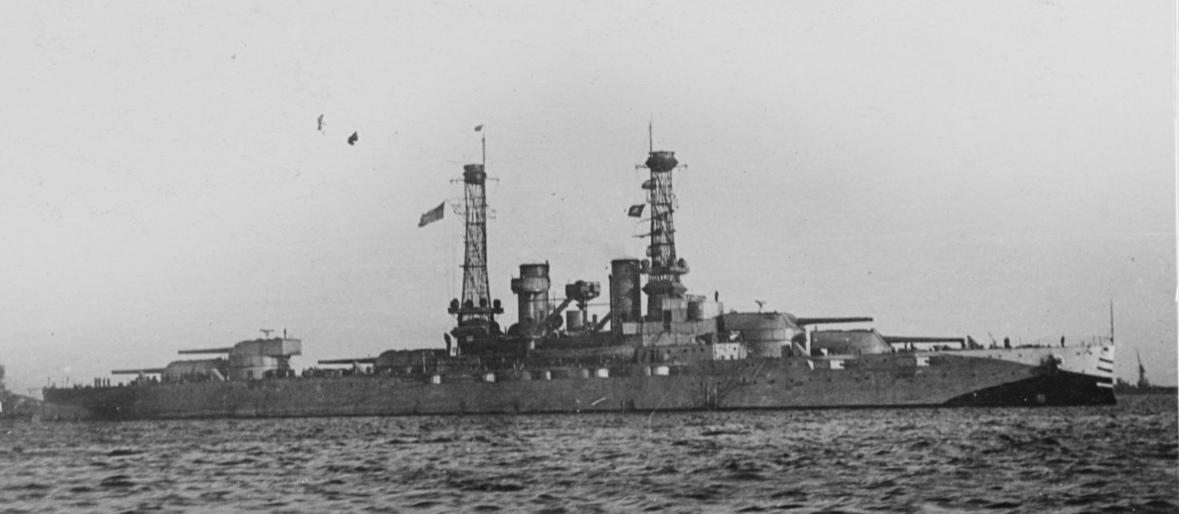
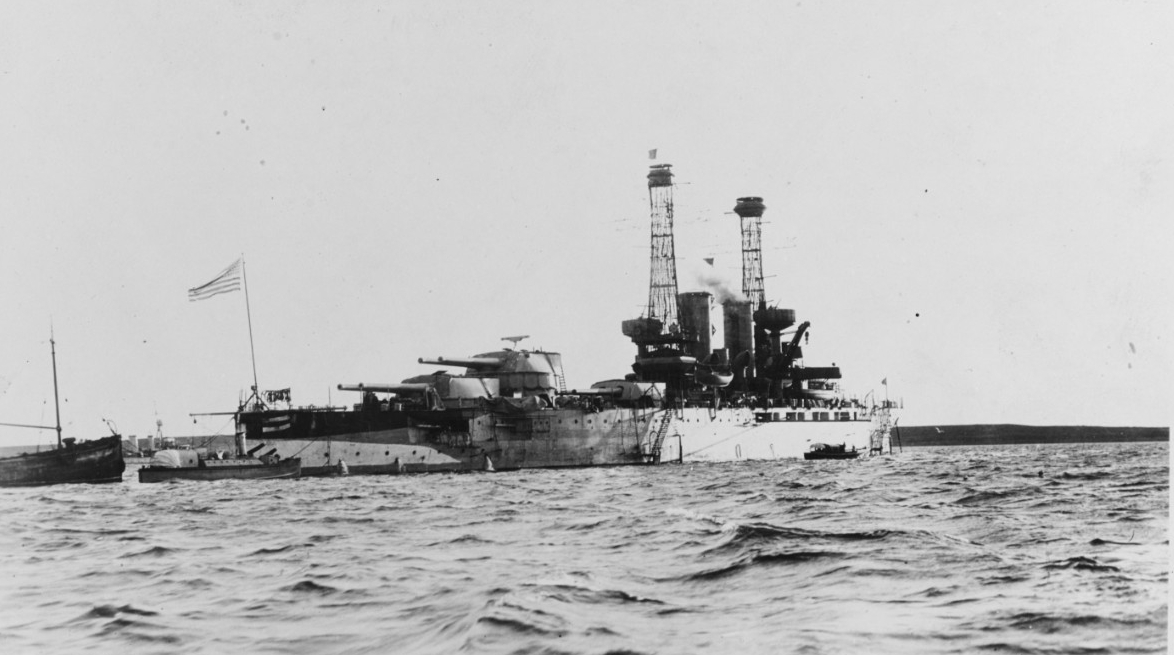
From its new base, the Sixth Battle Squadron, steamed out on what would be its final Scandinavian convoy escort mission on 17 April 1918. Ordered to escort convoy OZ25, the squadron steamed out of Rosyth with its destroyer escort right into a heavy gale. The storm forced a slowdown in order to ensure the safety of the destroyers. In the inhospitable conditions the convoy too was hindered; it spread to a distance of over sixty miles and was delayed 24 hours. The outbound convoy got underway on the 19th, as the storm was waning. The squadron rendezvoused and provided cover on the westbound passage until 8:00 p.m. Parting company, the warships returned homeward and stood into Rosyth around 4:25 p.m. on the 20th.
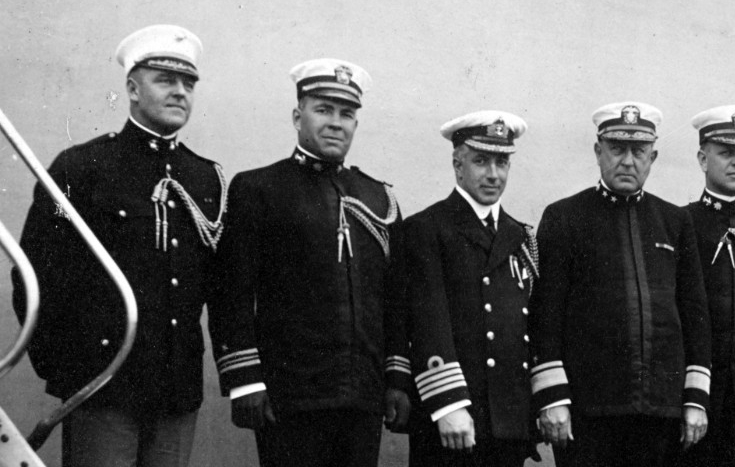
During her service with the Grand Fleet, New York was frequently visited by royal and other high-ranking representatives of the Allies. The Duke and Duchess of Athol visited the ship in May 1918. They were followed by King Albert I and Queen Elisabeth of Belgium on 9 July; His Royal Highness King George V on 20 July; and Crown Prince (later Emperor) Hirohito of Japan and his staff on 3 November 1918.
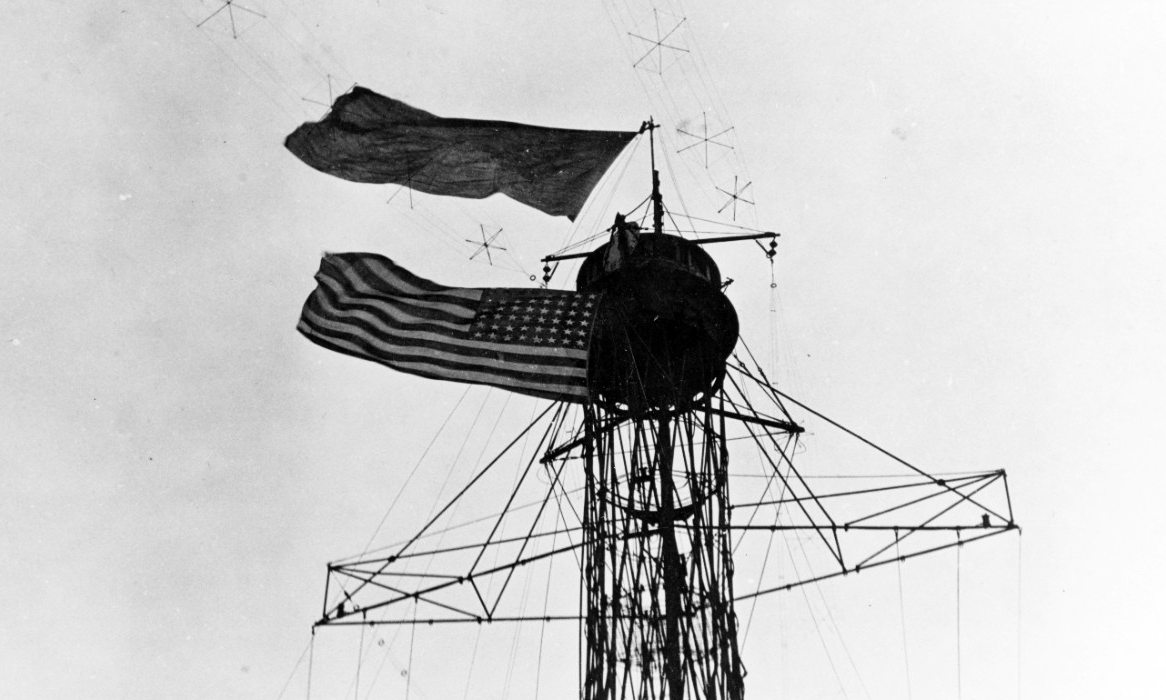
New York, on 14 October 1918, struck a submerged object while entering Pentland Firth enroute to Scapa Flow. She was underway in the channel normally traversed by Grand Fleet battleships. Though neither German nor British records confirm it, it was possible that she struck and sank a U-boat, as German submarines were known to have been patrolling the area. The collision resulted in New York losing a propeller blade and damaging another on her starboard screw. She docked at Rosyth, on 15 October 1918, and the squadron flag was temporarily shifted to Wyoming. With those repairs completed, Rear Adm. Rodman returned to New York on 21 October. During this period, New York also had to contend with the Spanish influenza pandemic. As of 9 November, the ship had forty-nine cases, including one death, from the outbreak.
The Armistice and the end of hostilities on 11 November 1918, found New York back with the fleet. With the pending arrival of the Imperial German High Seas Fleet, New York again hosted King George V, this time accompanied by the Prince of Wales, Adm. Beatty, and Vice Adm. William S. Sims, Commander, U.S. Naval Forces in European Waters on 20 November.
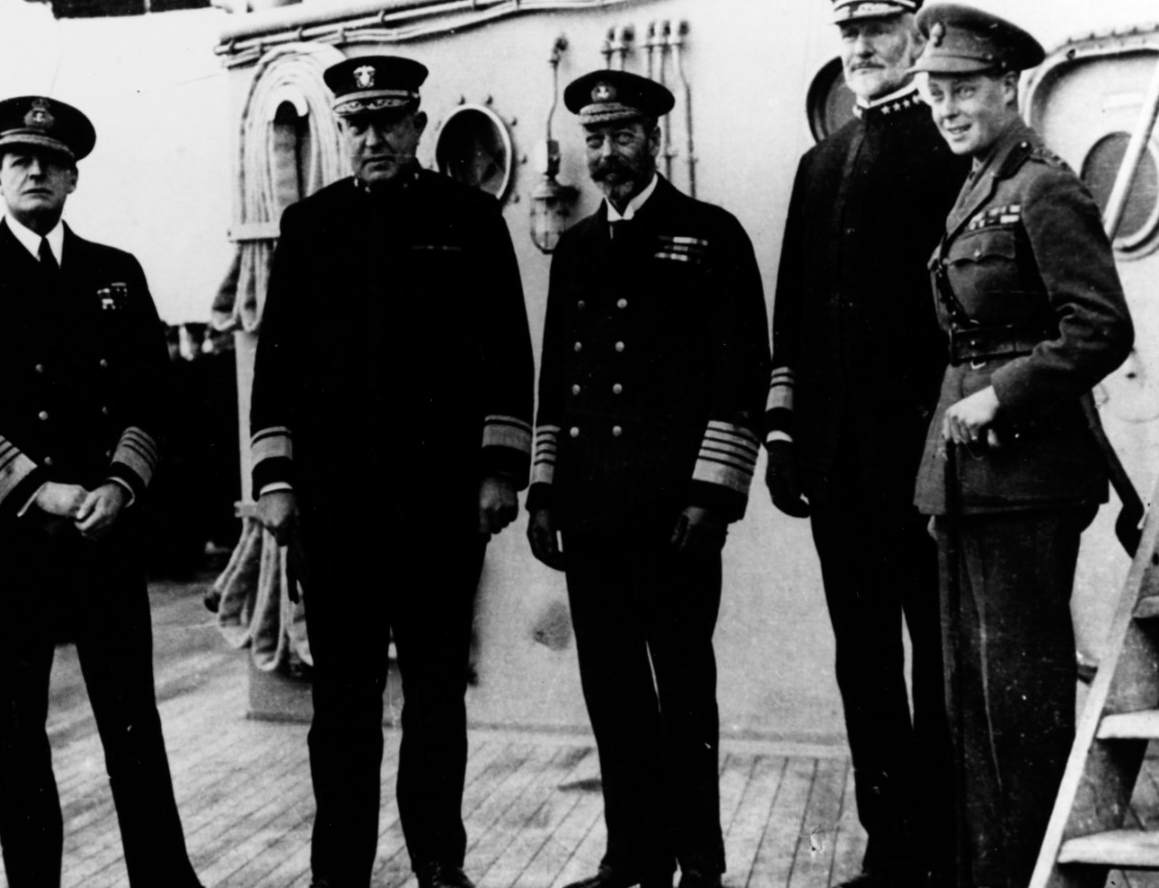
New York, with Vice Adm. William S. Sims still embarked, took up her position in column with the entirety of the Grand Fleet in the Firth of Forth on 21 November 1918, to accept the surrender of the High Seas Fleet.
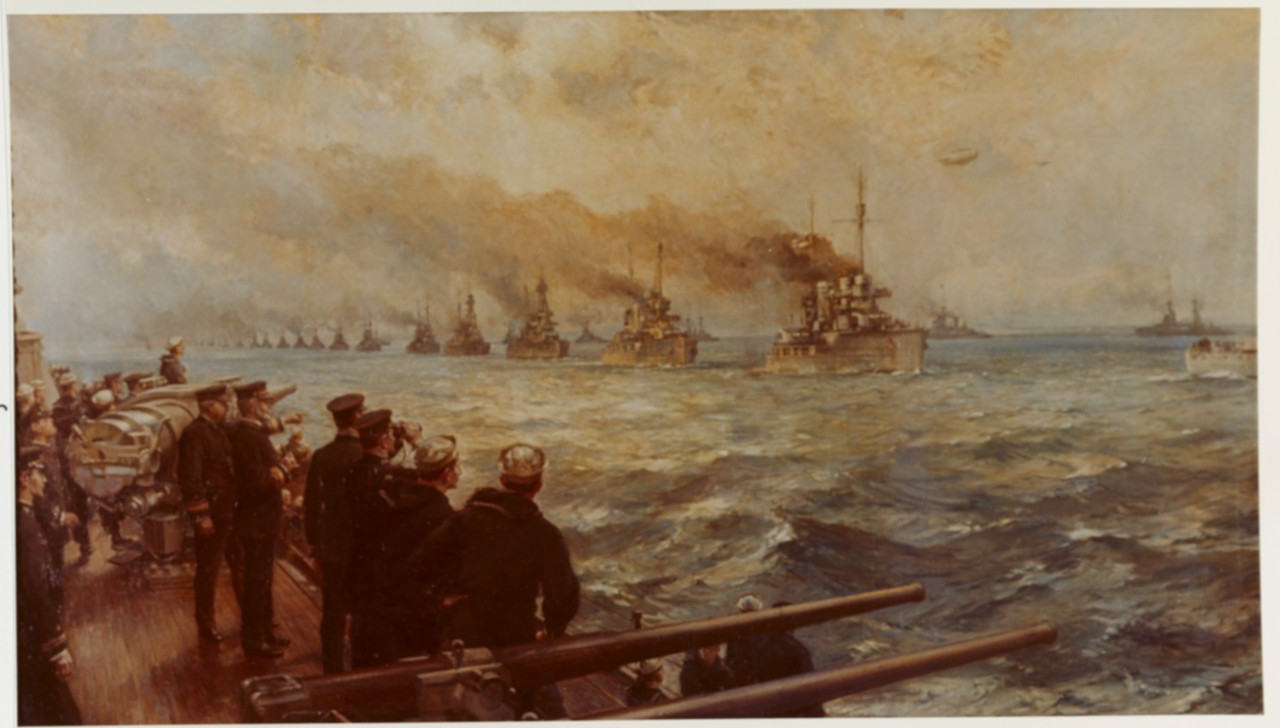
New York departed Rosyth on 1 December 1918 Scotland, for Portland, England, arriving on the 4th. Remaining there until 12 December, the battleship got underway for Brest, France, to rendezvous with Pennsylvania (Battleship No. 38), flagship of the Atlantic Fleet, as she escorted George Washington (Id. No. 3018) with President Woodrow Wilson -- en route to the Paris Peace Conference -- embarked. Having rendezvoused on the 13th, New York passed in review for President Wilson and escorted him into Brest Harbor. The next day, New York and the other battleships present, stood out of Brest bound for New York. While enroute home on 20 December 1918, the battleships encountered heavy seas and rolled heavily. On 26 December, they entered New York harbor and passed the converted yacht Mayflower anchored off the Statue of Liberty with Secretary of the Navy Josephus Daniels embarked; each fired a 19-gun salute; and anchored in the North River. Battalions from the various ships formed and paraded through the streets of New York celebrating the end of hostilities.
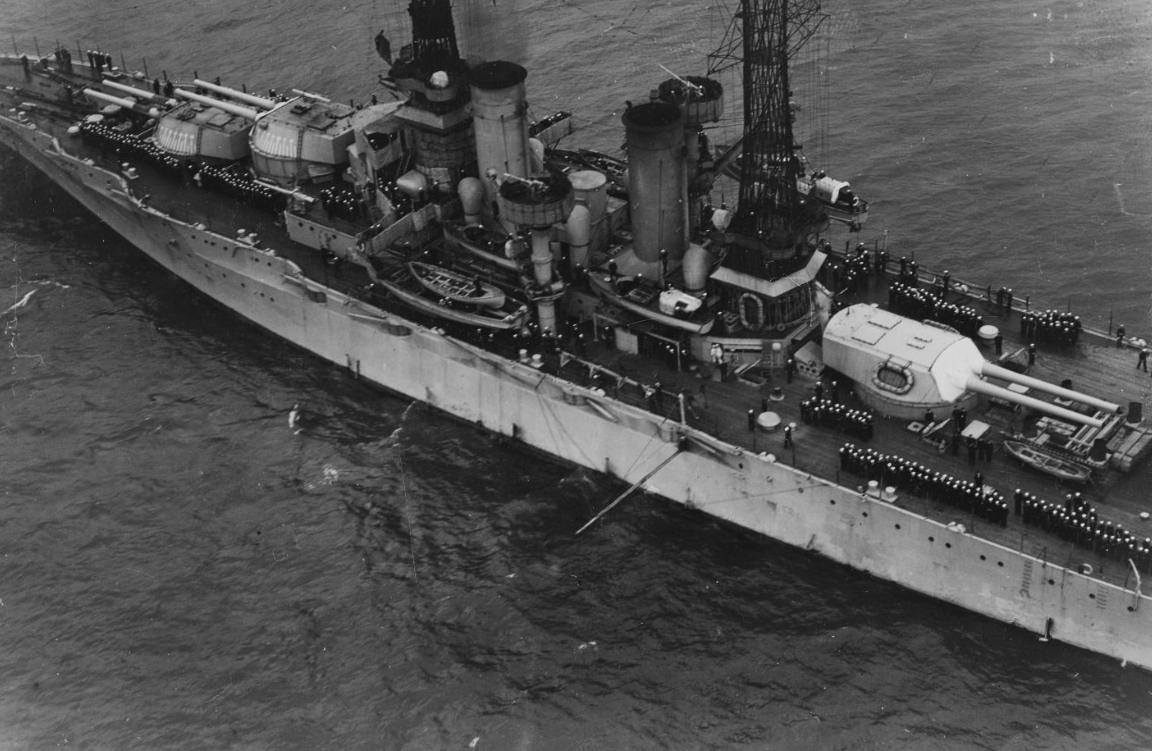
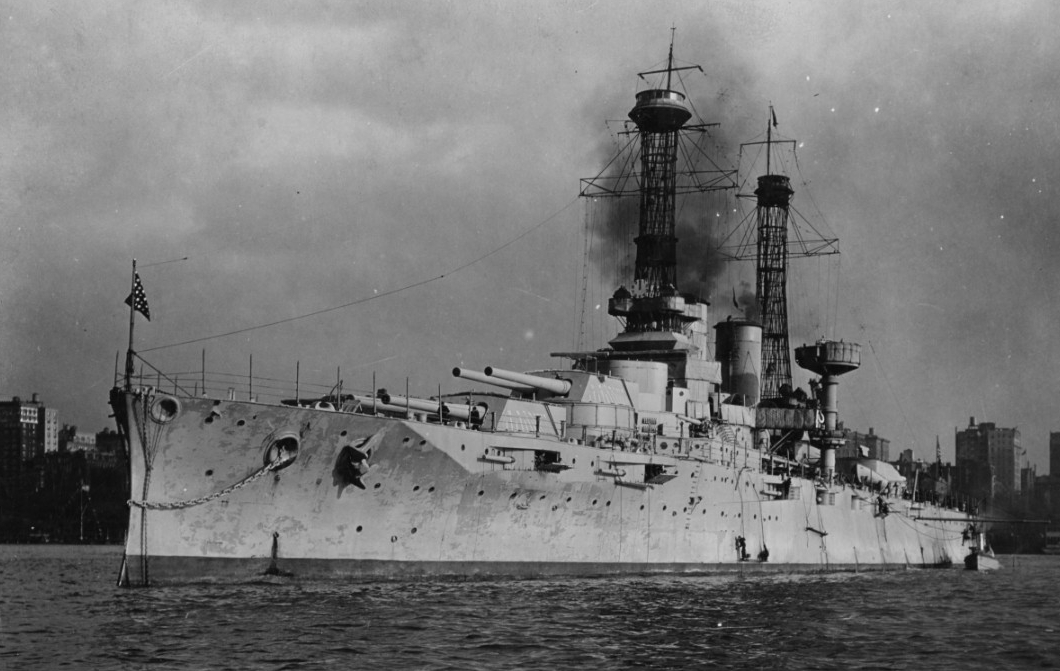
New York, on 3 January 1919, got underway from berth No. 5 in the North River and headed to the New York Navy Yard via the channel between the Battery and Governors Island with a pilot on board. Enroute she struck bottom and damaged her outer plating. This prompted a memorandum for improving the channel to the Navy Yard. Upon arrival, the battleship docked at Berth No. 4. High winds as the ship was entering the dock, pushed her into the Brazilian battleship Sao Paulo, docked in Berth No. 3, causing damage to the gangways of both ships. Once docked, New York underwent maintenance until 1 February, when she got underway bound for Hampton Roads. Arriving the next day, she remained there until 4 February, when she departed for Guantanamo and annual fleet tactical training and gunnery exercises. New York operated in Caribbean waters until her departure from Guantanamo on 9 April. Steaming to New York, she arrived on 14 April and later anchored in the North River on the 26th.
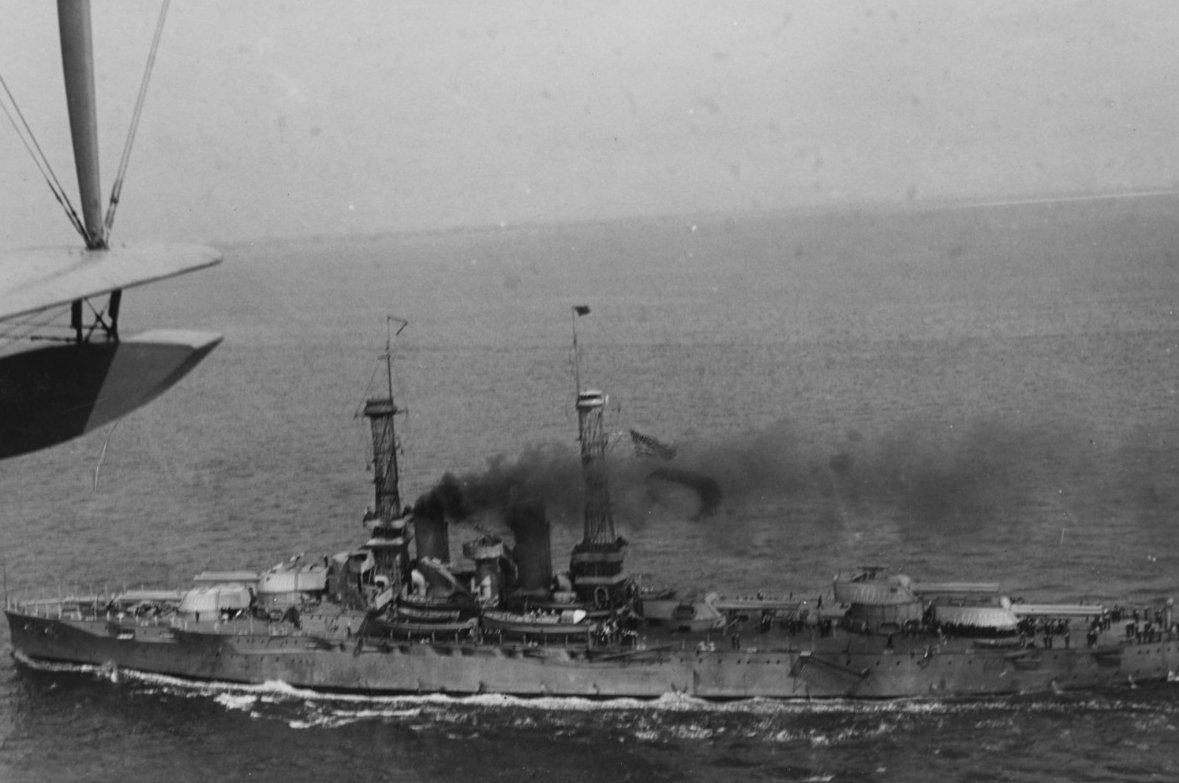
Into late June 1919, she shuttled between New York and the Chesapeake with visits to Hampton Roads and Annapolis. Having anchored in the North River (19-28 June), New York shifted to the New York Navy Yard in preparation for a re-assignment to the Pacific Ocean. Standing out of New York on 14 July, the battleship steamed to Hampton Roads (14-19 July), then on to the Canal Zone, arriving at Colon on the 25th. Transiting the Panama Canal for the first time on 26 July, New York departed Balboa, C.Z., on 27 July enroute to Coronado Island, Calif., and arrived on 6 August.
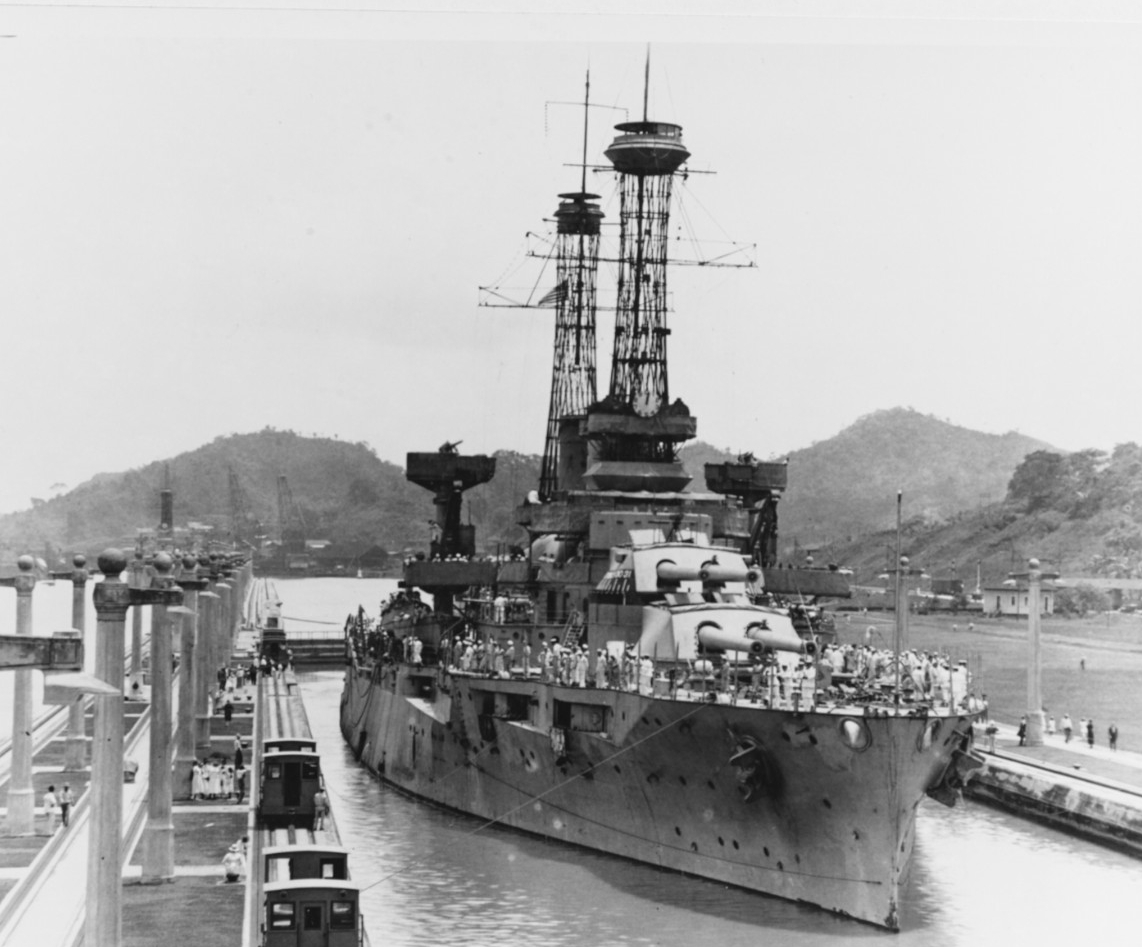
The next day she moved to San Diego, Calif., then on to San Pedro, Calif., on the 9th. After three days, she got underway bound for the Hawaiian Territory, arriving at Honolulu, T.H., on 20 August 1919. After visiting Hilo, T.H., she departed for the West Coast on 25 August and arrived at San Francisco, Calif., via Monterey, Calif., on 1 September. Passing back through the Golden Gate on 9 September bound for the Pacific Northwest. After visiting Seattle, Wash. (14-15 September), and Tacoma, Wash., (15 September), New York entered the Bremerton [Wash.] Navy Yard on the 15th for a yard period which again saw her in need of repairs to blades on her screws. She remained at Bremerton undergoing maintenance well into the next year as an investigation deemed her not ready for war service until those repairs and others to the portside hull were completed.
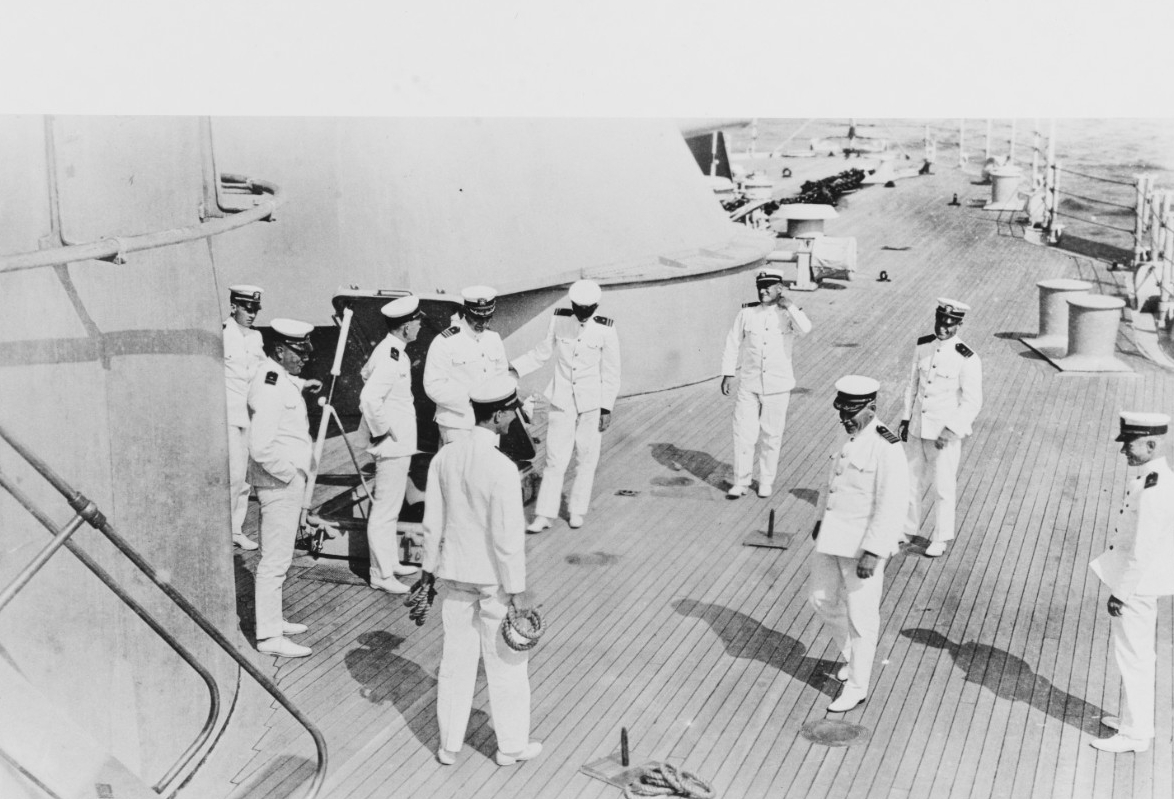
After nine months in the yard, New York steamed out of Bremerton on15 June 1920 bound for San Francisco, via Bolinas Bay, Calif., and arrived at her destination on 24 June. From 6 July through the end of the year, the battleship operated along the West Coast conducting training and routine operations underway based from San Francisco. Making multiple visits to San Pedro during that time, New York also visited the Hawaiian Islands (8-24 September) and Bremerton (4-13 December) before returning to San Francisco on 16 December. She would remain there through the end of the year.
With the new year, New York stood out of San Francisco on 6 January 1921, bound for Valparaiso, Chile. Stopping at Balboa (17-22 January), the battleship raised the Chilean capital on the 31st. After a five-day visit, she charted a course northward to return to California. Again stopping at Balboa enroute (14-25 February), New York arrived at San Pedro on 8 March.
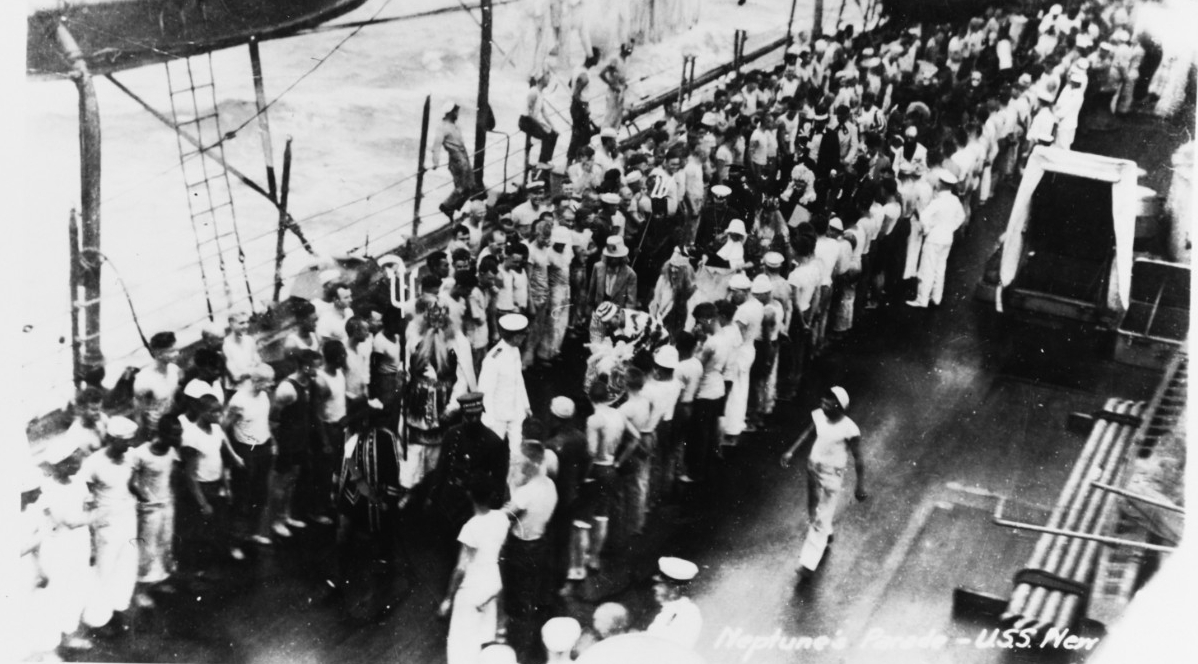
New York raised steam and got underway again on 1 June 1921 bound for Bremerton. Arriving on the 5th, she remained at Bremerton until 29 July. Over the next month, she operated in the waters of the Pacific Northwest calling at Seattle, Port Angeles, Wash., and Vancouver, British Columbia.
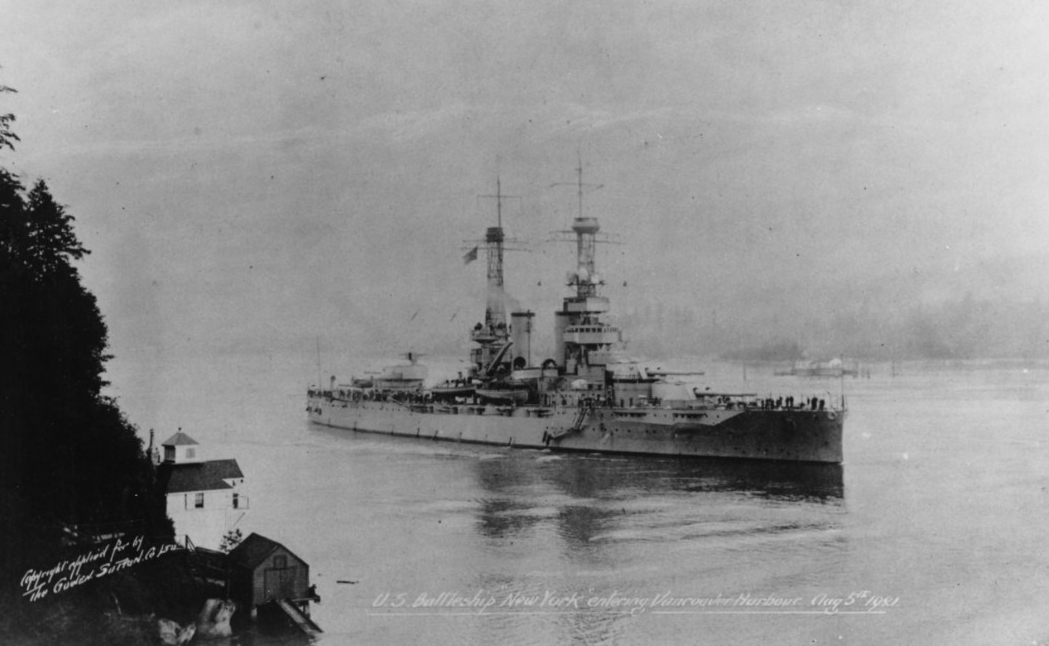
Departing Port Angeles on 22 August 1921, New York returned to San Francisco on 24 August. Getting underway on 6 September, she shifted to San Pedro. Arriving on 8 September, she remained in port there until 26 November. Steaming out of San Pedro on the 26th, she arrived at Bremerton on 1 December and spent the remainder of 1921 there. It should be noted that during the battle practices for Gunnery Year 1921-1922, New York won the Gunnery Trophy as the best-shooting battleship in the U.S. Fleet.
Having spent the holiday season there, New York steamed out of Bremerton on 7 January 1922 for a return to San Pedro. After visiting California City, Calif. (10-12 January), she stood into San Pedro on 14 January. Remaining in port for a month, she went to sea on 15 February bound for San Francisco. Arriving on the 17th, she stayed there until 13 March, getting underway again for a return to San Pedro and another month long period in port. Between April and October, New York cruised the Pacific Coast conducting training and making port visits in California and Washington. Entering the yard at Bremerton on 1 November, she underwent maintenance through Christmas Day. During her time at the yard, the General Order 94 of 6 December 1922 organized the United States Fleet, with the Battle Fleet as the Pacific presence stationed on the West coast. Departing Bremerton on 27 December, she arrived at San Diego on New Year’s Eve.
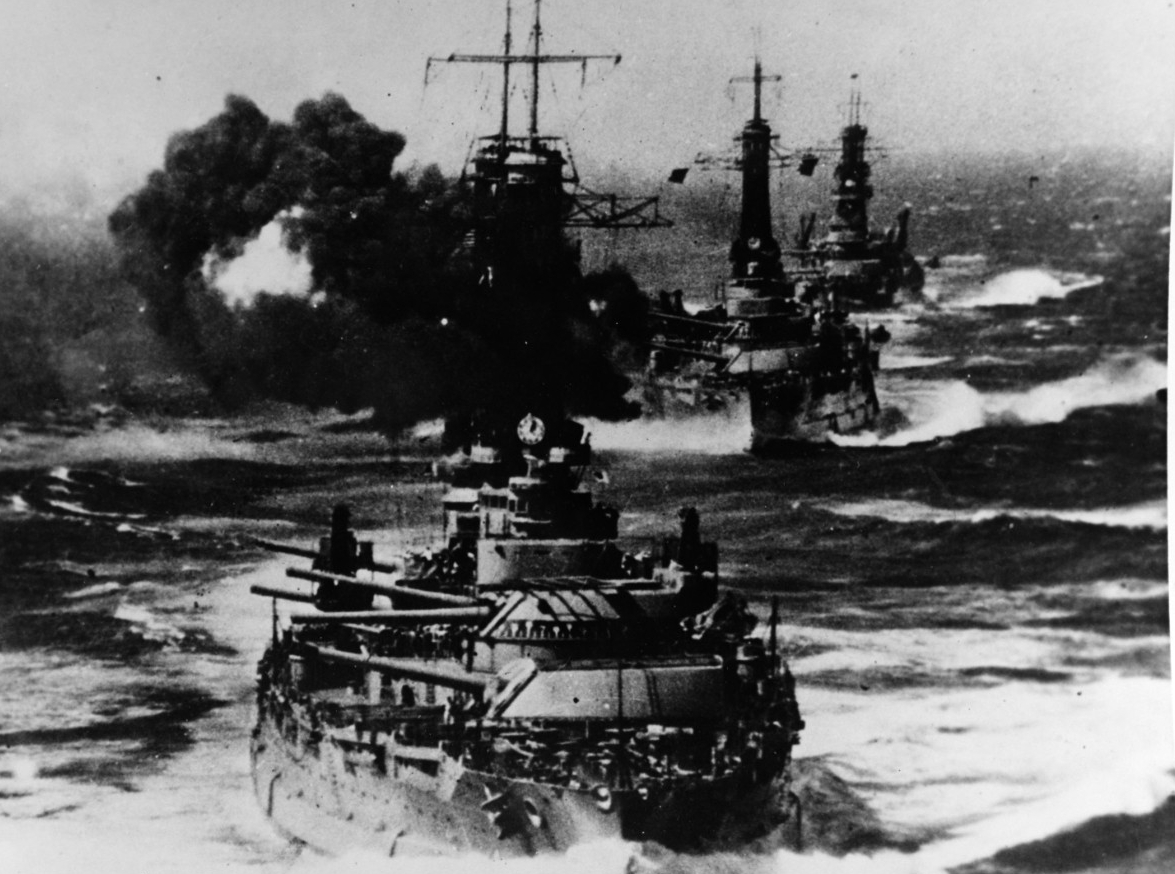
Spending New Year’s Day 1923 in port, New York got underway again on 5 January and arrived that same day at San Pedro. After a month in port, she got underway for San Diego on 5 February and returned the next. Two days later, on 8 February, New York departed San Pedro bound for Panama and the first of what became the Navy’s annual fleet problems. New York was part of the notional “Black Fleet” under the command of Adm. Edward W. Eberle, Commander, Battle Fleet. She, along with Oklahoma, served as a “constructive” aircraft carrier, akin to Langley (CV-1), still then under construction. During the exercise (18-22 February), the battleship operated in the vicinity of Puerto Culebra, Costa Rica (21-23 February) before moving on to Balboa on the 26th. The fleet remained in Panamanian waters well into March.
After operating off Panama for over a month, New York departed Balboa for San Pedro on 31 March 1923. With a brief visit at San Diego (11-12 April), she arrived at her destination later on the 12th. Remaining in port until 5 June, the battleship raised steam and got underway. Bound for Bremerton, she arrived on 9 June and entered the yard, where she remained until 6 October. Steaming out of Bremerton after her yard work, New York set a course for a return to San Pedro, via San Francisco (9-10 October) and reaching on 11 October. The warship did not get underway again until 20 November when she made an overnight visit to San Diego and returned to San Pedro. She again made a short visit to San Diego (11-13 December). With her return to San Pedro on the 13th, New York did not get underway again until 1924.
New York stood out of San Pedro on 2 January 1924 bound for what became Fleet Problems II, III, and IV (2 January-1 February 1924). The exercises simulated the phases of a prolonged naval campaign. Arriving at Balboa on the 16th, she passed back through the Panama Canal and returned to the Atlantic Ocean on 25 January. Departing Colon, C.Z., on the 25th, the battleship steamed to Culebra, P.R. Arriving on 11 February, she operated in the waters around Culebra over the next two weeks.
Weighing anchor, New York set a northbound course on 25 February 1924, and stood into the anchorage at the North River on 3 March. She entered the New York Navy Yard on 6 March and underwent repairs until the 27th. Shifting to the Norfolk [Va.] Navy Yard, she arrived on the 28th, entered the yard, and underwent further repairs until 30 April. Undergoing trials she operated in the vicinity of Hampton Roads and on the Southern Drill Grounds through 20 May, when she went to sea and arrived at Guantanamo and Cardenas Bay, Cuba, on the 23rd. Passing through the Virginia capes on 30 May, she steamed up the Chesapeake to Annapolis, Md. There she embarked Naval Academy midshipmen for a summer cruise to Europe. Standing out of Annapolis on 6 June, New York passed back through the capes and across the Atlantic. She made port visits to Torbay, England (18 June-25 June); Brest (29 June-7 July); Antwerp, Belgium (16-25 July); Gibraltar (31 July-4 August); and Ponta Delgada, Azores (8-9 August). Steaming back across the Atlantic, New York conducted training on the Southern Drill Grounds and around Hampton Roads (17-22 August) and in the Chesapeake Bay (22-27 August) returning to Annapolis, the midshipmen disembarked on 27-28 August, and the battleship returned to Hampton Roads on the 29th. Departing the next day, she steamed to Newport. Arriving on the 31st, she remained until 8 September, then got underway to conduct training on the Southern Drill Grounds. Over the next six weeks, she alternated between time at Hampton Roads and on the Southern Drill Grounds. Having concluded these iterations, she shifted from Hampton Roads on 23 October and docked at the Norfolk Navy Yard. New York remained at the yard through the new year.
New York undocked on 4 January 1925, and shifted to Hampton Roads. Getting underway two days later, she was bound for Guantanamo. Raising Cuba on 10 January, she remained in the Caribbean until 28 March, getting underway for a return to New York and anchored in the North River on 2 April. Departing on the 13th, she steamed to Hampton Roads. She arrived the next day and entered the Norfolk Navy Yard the next day. Undocking on 27 May, she moved to Hampton Roads for two days, then steamed up the Chesapeake to Annapolis. Embarking midshipmen, she remained at Annapolis until 6 June, when she stood down the bay bound for the Canal Zone, arriving at Cristobal on 13 June. Transiting the Panama Canal, New York returned to the Pacific Ocean on the 17th. She then set a course for San Pedro, arriving on the 29th. After a time in port, she weighed anchor and steamed out of San Pedro northward on 8 July. The battleship continued the midshipmen cruise visiting San Francisco (9-17 July), Astoria, Ore. (21-23 July), and Seattle (24-31 July). Returning south, she stopped at San Diego (3-8 August) enroute to the Canal Zone where she arrived on the 19th. Transiting back through the Panama Canal on the 20th, she departed Colon that same day bound for Annapolis. Arriving at the Naval Academy on 28 August, New York disembarked the midshipmen and departed the next day. Arriving later on the 29th at Hampton Roads, she docked at the Norfolk Navy Yard on 31 August, undergoing a post-deployment overhaul until 3 October. Steaming out of the yard that same day, she was on a southward heading for the Greater Antilles. Raising Cuba on 7 October, she spent the next two months conducting training at Guantanamo and cruising the Caribbean with port visits to Gonaïves, Haiti (25-28 October) and Kingston, Jamaica (31 October-2 November). Departing Guantanamo on 19 November, she steamed between Cape Charles, Va. and Cape Henry, Va., to Hampton Roads on 23 November, enroute to docking at the Norfolk Navy Yard. She remained in the yard throughout the holiday season.
With her yard period complete, New York steamed out to sea bound for Guantanamo on 14 January 1926, and arrived two days later. After two weeks, she departed on 1 February and steamed to Colon, where she arrived on 4 February. The next day she went to sea. During this time, she participated in Fleet Problem VI, simulating an attack on Manila, in the Philippine Islands, and passing back through Panama Canal to Balboa and the Pacific Ocean. From Balboa, New York went to sea to conduct training five times between 23 February and 5 March. Ten days later, she passed back through the Canal to Colon. On the 17th, she steamed to Guantanamo via Guacanayabo. Arriving at Guantanamo on 23 March, she operated in Cuban waters until 27 April, when she headed northward for Hampton Roads. Arriving on 1 May, she entered the Norfolk Navy Yard the next day and underwent overhaul until 27 May. Departing the next day, ship returned to the Naval Academy to embark midshipmen for another summer cruise. Getting underway on 4 June, New York steamed for New England. Arriving at Menemsha Bight, Martha’s Vineyard, Mass. on 8 June, the ship conducted training based from this location for two days before moving on to Newport on 10 June. Weighing anchor on the 15th, she cruised along the New England coast making visits at Marblehead, Mass. (16-19 June), Portland, Maine (20-22 June), and Charlestown, Mass. (26-29 June), before anchoring in the North River on 2 July. After a time in New York, she departed on 6 July for Newport (7-15 July) and Philadelphia, Pa. (16-26 July). Continuing the midshipmen cruise, the battleship headed to the Caribbean to conduct training at Guantanamo and Gonaïves before returning to the Chesapeake on 25 August. By the 26th New York had returned to Annapolis to disembark the midshipmen. Weighing anchor the next day, she returned to Hampton Roads and entered the Norfolk Navy Yard on 28 August was placed in reduced commission to undergo a major modernization program to improve her propulsion systems to increase her speed and to improve her armor and armament.
The ship’s 3-inch anti-aircraft defense guns were increased to eight and six of her 5-inch guns were relocated on the main deck. Her torpedo tubes were removed and her coal-fired boilers replaced with oil burners. Her funnels were trunked into a single stack aft of the forward superstructure and her lattice masts were replaced by tripod masts with control towers. A tower was built amidships that contained additional fire control to backup the system on the foremast. A new aircraft catapult atop Turret III and cranes on either side of the funnel for boat and aircraft handling were installed. She received additional deck armor and her beam was widened to 106 feet with the installation of anti-torpedo bulges. These, however, made maneuvering harder at low speeds and she also rolled badly which reduced her gunnery accuracy in rough seas. With the modifications, New York also displaced an additional 3,000 tons.
New York was restored to full commission at the Norfolk Navy Yard on 16 September 1927. She finally got underway and went to sea on 10 October. Passing through the Virginia capes, she undertook a shakedown cruise to the Caribbean, arriving at Guantanamo Bay on 15 October. Though she did make a brief visit to Port-au-Prince, Haiti (22-24 October), the battleship operated from and around Guantanamo until 25 October, when she departed Cuba for a return to Norfolk. Re-entering the Navy Yard on 5 November, she underwent follow-on maintenance and preparations for a return to the West Coast. Standing out of Norfolk on 1 December, New York raised Colon on the 7th. Passing through the Panama Canal to Balboa the next day, she departed on 10 December and moored at San Pedro on 22 December. Having returned to her Pacific home, she remained in port well into January.
Resuming her operations underway on 20 January 1928, New York made a series of short-term training exercises at sea along with visits to Coronado Roads, Calif., and San Diego to 24 March. After just over two weeks in port, she weighed anchor on 9 April and steamed to San Francisco. Arriving the next day, she remained until the 18th when she got underway bound for the Hawaiian Territory as part of Fleet Problem VII (18-28 April 1928). Arriving at Honolulu on the 28th, she remained in Hawaiian waters conducting training and participating in follow on exercises into June. New York departed Honolulu on 16 June and stood into San Francisco on 23 June. She remained in port until 16 July, when she got underway for San Pedro, arriving the next day. Getting underway on the 18th, she returned to San Pedro that same. The following day, 19 July, she steamed to San Francisco and arrived the following day. Remaining until 26 July, she then set a course for the Pacific Northwest. Arriving at Seattle on the 29th, the battleship remained there until 13 August, when she shifted to Port Angeles. Finally departing on 18 August, she visited San Francisco (24-31 August) before returning to San Pedro via Long Beach, Calif., on 2 September. For the next three months, New York operated out of San Pedro periodically going to sea for training. Having spent Christmas Day in port, she got underway on 26 December, headed for Bremerton. New York entered the yard on New Year’s Eve and underwent overhaul into February.
New York completed her yard work on 15 February 1929 and steamed homeward. Touching at San Francisco on the 18th, she returned to San Pedro on 19 February. Getting underway on the 22nd, she steamed to Corinto, Nicaragua, via Coronado Roads and arrived at her destination on 3 March. Remaining briefly, she moved on toward Balboa, arriving on 6 March. The next day she crossed the isthmus to Cristobal from whence she departed, that same day, for Guantanamo. Arriving on 9 March, New York remained in the waters around Guantanamo into late April. Getting underway on the 27th, she arrived at New York, via Cape Hatteras (30 April) and Hampton Roads (1 May), on the 2nd. Anchoring in the North River, she remained until 13 May, when she departed for Hampton Roads. After a month at Hampton Roads, the battleship departed on 15 June for Charleston [S.C.] light vessel. Arriving on the 17th, she departed northward that same day for the Boston [Mass.] Navy Yard reaching on the 21st. Remaining at the yard overnight, she departed on the 22nd, for St. George’s, Bermuda. After a two-day visit (25-27 June), she moved on to Havana, reaching on 2 July. After four days visiting the Cuban capital, New York got underway for a return to the United States. Arriving in the vicinity of Charleston light vessel on 8 July, she continued on and arrived at Newport, via the Delaware Breakwater, on 16 July. With periods in port, she operated from Newport through 15 August when she shifted to New York. Arriving the next day, the battleship anchored again in the North River and remained there until the 26th. Standing into Hampton Roads on 27 August, New York would operate in this area and on the Southern Drill Grounds into November. The only exception was a cruise up the Chesapeake for a port visit to Baltimore, Md. (11-15 September). Departing the Norfolk Navy Yard on 20 November, she arrived at New York two days later. She then steamed to Boston on 12 December and entered the Boston Navy Yard on 14 December. She remained there through the Christmas and New Year’s holidays.
Three days into 1930, New York steamed out of the Boston Navy Yard and set a course south for a return to Hampton Roads. Reaching on 5 January, she remained until the 8th, when she passed between the Virginia capes enroute to Guantanamo. Arriving on 13 January, New York would remain in the West Indies conducting training into the spring. During this time she participated in Fleet Problem X (10-15 March). Departing Guantanamo on 2 April, the battleship arrived to days later at Colon. Passing through the Panama Canal to Balboa the next day, she then moved on to Corinto (7-8 April) before heading back to California. Touching at San Diego on the 14th, she arrived later that same day at San Pedro. Getting underway again the next day, she steamed north to Bremerton. Entering the yard on 19 April, she remained there undergoing overhaul until 4 August. Upon leaving the yard, she made her way back to San Pedro on the 27th after port visits at Seattle and San Francisco enroute. New York then stood in port at San Pedro until 8 November when she got underway for a two-day port visit to San Francisco (10-12 November). Returning to San Pedro on 13 November, New York spent the remainder of the year in port.
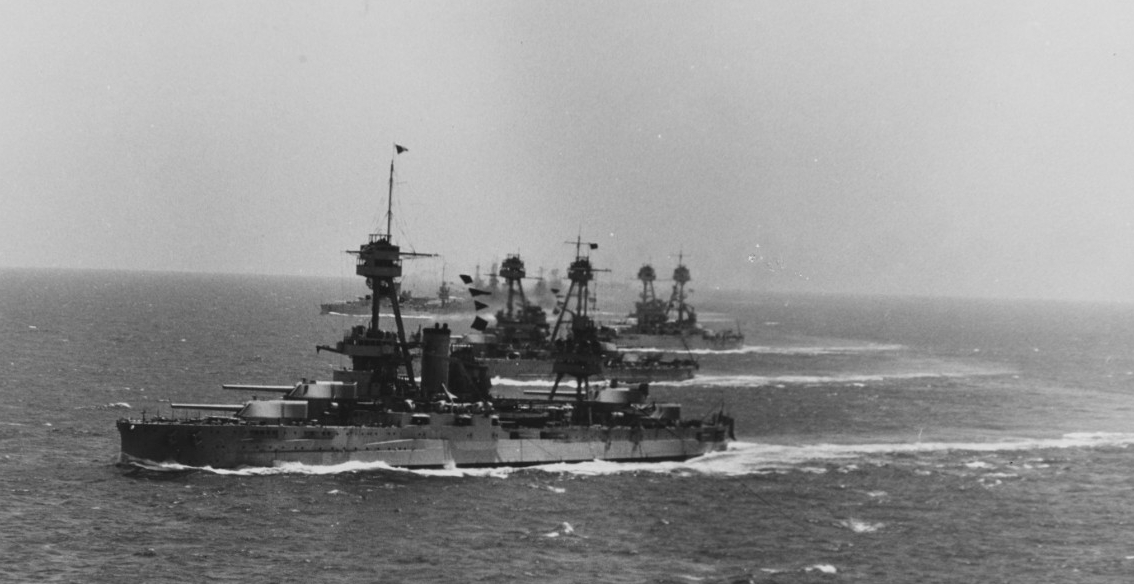
New York got underway for the first time in 1931 on 26 January when she stood out of San Pedro bound for a three-day visit to San Francisco (28-31 January). Returning to San Pedro on 1 February, she was in port until 5 February when she weighed anchor and went to sea for Fleet Problem XII (February-March). Participating in the exercise, the battleship arrived in Panama on 22 February and conducted operations in Gulf of Panama in the vicinity of the Islas de las Perlas. With the end of the fleet exercises, she departed Balboa on 23 March and stood into San Pedro on 4 April, remaining in port until 18 June. Getting underway, she made a short cruise to San Francisco (20 June-2 July) and Santa Barbara, Calif. (3-6 July) before returning to San Pedro on the 6th. When she got underway again on 27 July, she set a course to the Pacific Northwest. Enroute to Bremerton Navy Yard, she made visits to Tacoma, Wash. (1-7 August), Seattle (7-17 August), Port Angeles (17-19 August), and Bellingham, Wash. (17-24 August). She docked at the Navy Yard on 25 August and underwent overhaul until going to sea on 20 October. She arrived back at San Pedro on the 27th where she remained in port through year’s end, with the exception of a brief time underway to make a two-day visit to Santa Barbara (10-12 October).
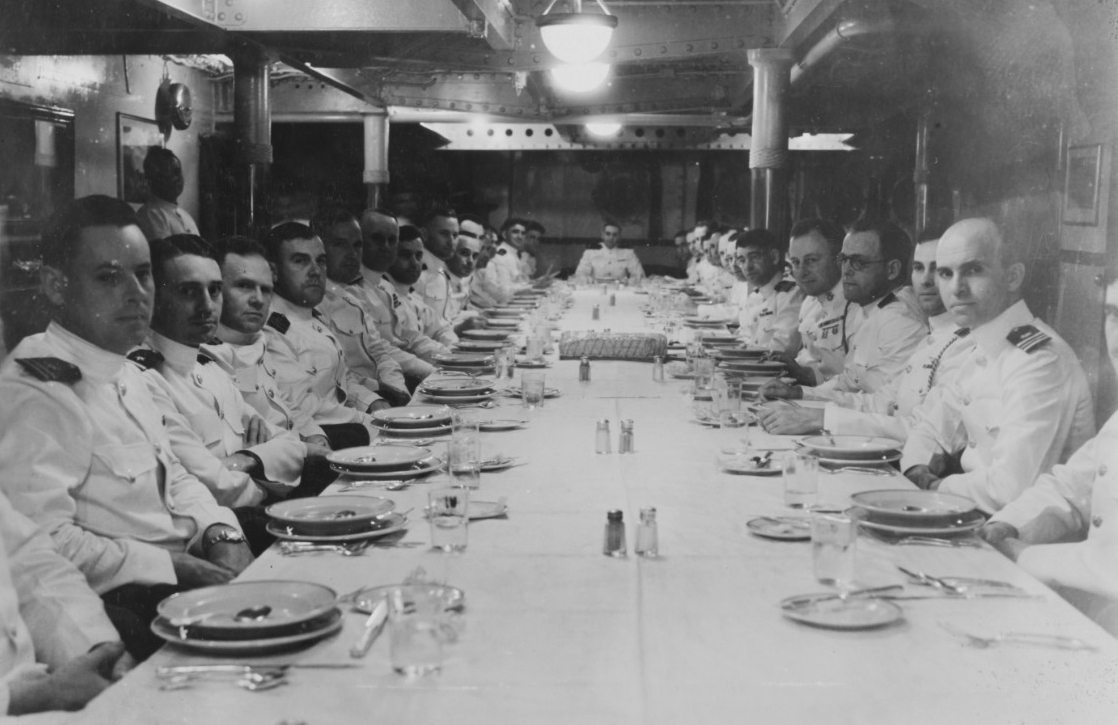
New York charted an outbound course from San Pedro on 1 February 1932. Bound for the Hawaiian Islands, the battleship was underway to join the fleet for Fleet Problem XIII (31 January-18 March). Arriving at the anchorage in Lahaina Roads on 13 February, New York operated in the area around the islands until departing from Hilo on the 29th. She arrived back at San Pedro on 22 March. Getting underway again on the 23rd, she arrived that same day at San Francisco and remained there until 12 May. With her departure from San Francisco, she returned to San Pedro the next day. Having remained in port for almost two months, the battleship shifted to Ocean Park, Calif. (2-5 July) and then returned home. Getting underway, she shuttled for a three-day visit to San Francisco (26-29 July) and returned to San Pedro on the 30th. Heading to sea on 12 August, New York steamed for Washington state, via San Francisco (14-18 August). Reaching Seattle on 21 August, she stayed until 1 September before making additional visits in Washington at Tacoma (1-8 September), Everett (8-12 September) and Port Angeles (12-16 September). Steaming south via San Francisco (21 September-3 October), she returned to San Pedro on 5 October. As in the previous year, she made a visit in the fall to Santa Barbara (10-14 November), and spent the holiday season in port at San Pedro.
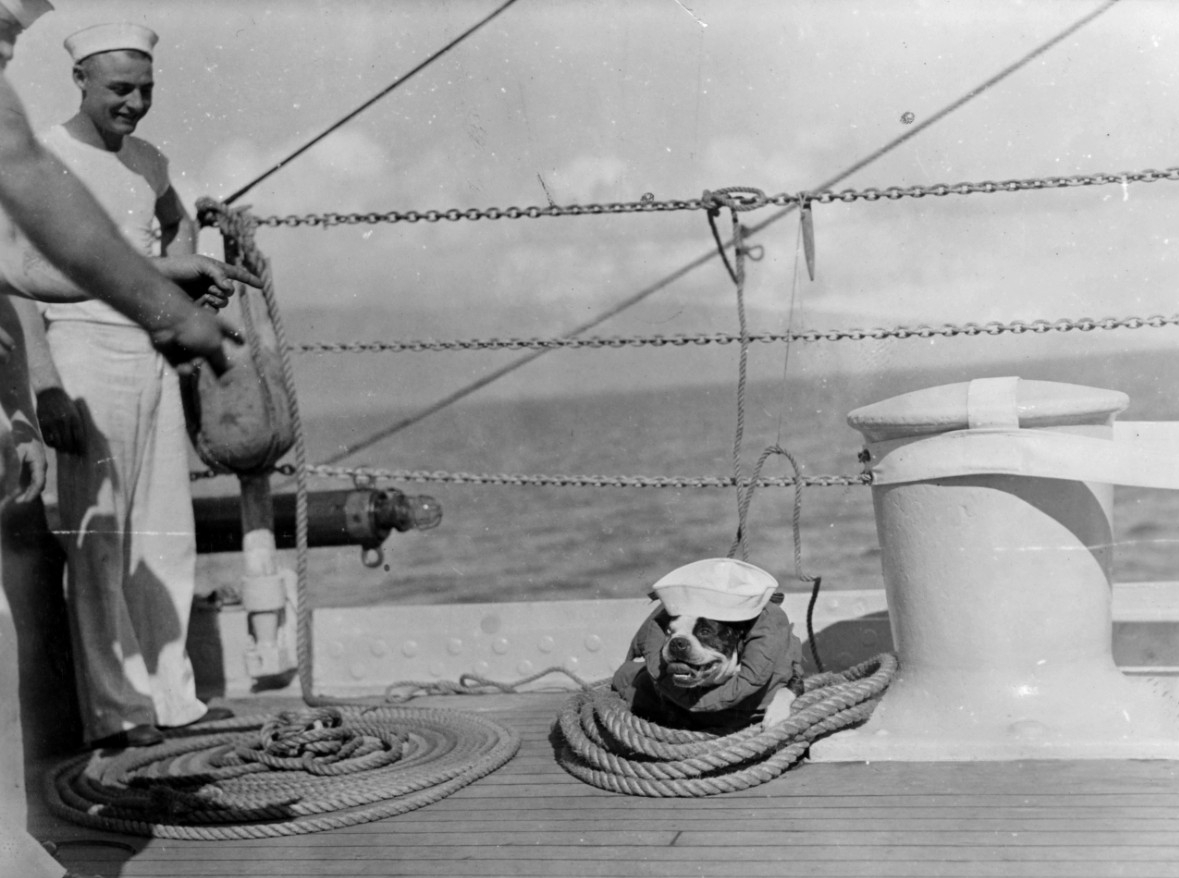
Getting underway for the first time in the new year on 9 February 1933, New York steamed out of San Pedro for a return to Bremerton and the Puget Sound Navy Yard on 9 February. Enroute she visited San Francisco (17-27 February) and Port Angeles (1 March). Arriving on 2 March, New York docked at the Puget Sound Navy Yard and underwent overhaul through 26 May. Going to sea for trials on the 26th, she returned the next day and went back into the yard until 6 June, when she set a course to return to San Pedro. Touching at San Francisco on 9 June, New York reached San Pedro on the 11th. Departing again on the 22nd, she shifted to Santa Barbara (22-30 June) and then steamed to San Francisco (1-6 July) enroute to a return to Washington state. Visiting Seattle, Everett, and Tacoma on her way, she reentered the Puget Sound Navy Yard on 5 August and remained for a week undergoing additional maintenance. Departing on 12 August, the battleship moved to San Francisco (15-23 August) before reaching San Pedro the next day. She stood in port for most of the remainder of the year, only getting underway to visit San Francisco (7-14 November).
New York got underway again on 9 March 1934, bound for a visit to San Francisco (10-14 March), conducting training enroute, she returned to San Pedro on the 16th. Setting a course for Balboa on 9 April, the battleship arrived off the Pacific coast of Panama on 21 April, to participate in Fleet Problem XV (19 April-12 May). This exercise saw New York transit the Panama Canal (24-25 April), depart Cristobal on 4 May, and conduct additional operations as in the Caribbean at Culebra, Gonaïves, and Guantanamo. Having drafted their post-exercise reports, New York and the other participating battleships departed Gonaïves on 25 May bound for New York. Arriving on 31 May, the fleet passed in review off the Ambrose light vessel for President Franklin D. Roosevelt, embarked on board Indianapolis (CA-35). With the heavy cruiser in the lead, the fleet then steamed into New York and anchored in the North River or tied up at piers on New York’s west side. After participating in a series of ceremonies and parades, New York steamed down the Hudson River bound for Newport. Reaching on the 22nd, she remained until 5 July, when she made a brief visit to the Boston Navy Yard. Afterward she operated between Newport and New York until 6 August when she set a course for Baltimore. Reaching on 9 August, she remained until the 13th, when she stood down the Chesapeake bound for the Southern Drill Grounds. After operating on the drill grounds (13-17 August), she arrived at Hampton Roads on 18 August and remained there until 19 September. Steaming to sea on the 19th, New York was bound for Panama and a return to the Pacific Ocean. Reaching Cristobal on 23 September, she transited the Canal to Balboa the same day. Departing the next day, she arrived back at San Pedro, via San Diego on 3 October. After a three day stay in port, she got underway for a return to the Puget Sound Navy Yard. Touching at San Francisco while enroute of 8 October, she arrived at the yard on the 11th. Docking for overhaul the next day, she remained until 8 January 1935.
With her yard work and trials completed, New York steamed southward and reached San Pedro on 12 January 1935. She got underway again on 11 February and arriving at San Francisco on the 13th, she remained there until departing on the 23rd and arriving back at San Pedro the next day. For two months, the battleship stood in port. Getting underway on 24 April she moved to San Francisco as part of her participation in Fleet Problem XVI (29 April-10 June). This exercise was to be the largest yet conducted by the Navy in the Pacific. It constituted multiple operations across 5 million square miles between the West Coast, the Hawaiian Territory, and the Aleutians. During this exercise, New York operated with Oklahoma as part of the “Black” force under Vice Adm. Arthur J. Hepburn. With the exercise completed, New York steamed out of Pearl Harbor, T.H., on 31 May and after a brief time at San Diego (10-11 June), she returned to San Pedro on the 11th. After almost three weeks in port, the battleship got underway for the Pacific Northwest on 1 July. Stopping at San Francisco (3-8 July), she moved on to Washington, making visits to Tacoma (12-22 July), Port Angeles (22-25 July), Everett (25-27 July), and Seattle (27 July-5 August). Enroute to a return to San Pedro, New York arrived at San Francisco on 9 August and docked at the yard at Hunters Point (12-14 August). She departed San Francisco on 19 August and returned to San Pedro via San Diego (23-30 August) on the 30th. Getting underway for training on 16 September, she returned to San Pedro on the 27th. She stood out of San Pedro again on 6 November to conduct training. Visiting San Francisco (8-12 November) while underway, she returned to San Pedro on 15 November and remained in port into the following year.
After almost four months in port, New York made turns and steamed out of San Pedro en route to San Francisco on 13 February 1936. Reaching on the 15th, she remained until the 24th, when she got underway to return to the Puget Sound Navy Yard. Arriving via Restoration Point, Wash., the battleship entered the yard on 26 February and underwent overhaul until 2 June. Upon leaving the yard, she set a course for San Francisco where she stayed from 5-15 June, before returning northward. Arriving at Seattle on 17 June, the ship remained two days and then departing for Honolulu via Hilo. She arrived on 30 June. Remaining until 3 July, she steamed back to Seattle, via San Francisco (10-12 July), and arrived on the 15th. Entering the Puget Sound Navy Yard that same day, she underwent repairs until the 30th. Standing out of the yard, she returned to the Hawaiian Islands. Arriving off Pearl Harbor on 7 August, she remained there until the 13th, when she got underway to return to California. New York reached San Pedro on the 22nd. She remained in port for most of the rest of the year. She only got underway on 9 November for a visit to San Francisco (10-16 November) and returned to San Pedro on 18 November.
New York got underway for the first time in the new year on 28 January 1937. Standing out of San Pedro she would spend the next several weeks shuttling between San Diego, San Clemente, and San Pedro. Returning to San Pedro on 25 February, she remained in port of just over a week. Departing on 3 March, New York touched at San Diego enroute to Balboa, where she arrived on the 13th. Transiting the Panama Canal on 15 March, she entered the Atlantic side of the isthmus and carried on with her passage. Bound for Port au Prince, she arrived on 18 March. Departing the next day, New York returned to the Norfolk Navy Yard on the 23rd and docked until 21 April. Shifting to Hampton Roads after a short time underway on the 21st, she remained at Hampton Roads until 24 April when she got underway bound for Europe with Adm. Rodman, the President's personal representative for the coronation of King George VI, embarked. The battleship arrived at Cherbourg, France, on 4 May. She then crossed the English Channel to Portsmouth, England, on the 10th. After eight days there, she moved to Spithead, England preparatory to the Grand Naval Review. New York as the sole U.S. Navy representative, took part in the review on 20 May. With the review completed, the ship stood out of Spithead enroute to a return to Norfolk on the 21st and arrived on 30 May. Three days later, on 2 June, she steamed up the Chesapeake to Annapolis and embarked midshipmen for another summer’s cruise. Getting underway the next day, the battleship reentered the Atlantic and steamed eastward for a return to Europe. Reaching Cuxhaven, Germany, on 20 June, she remained overnight and the next day shifted to Kiel, Germany where she conducted a port visit until the 29th. Steaming out of Kiel, she set a course for Portugal. Arriving at Lisbon on 6 July, she remained until the 9th, when she shifted to Funchal, Madeira Islands. Weighing anchor on 12 July, New York got underway and reached Torbay on 18 July. After eleven days in port, she stood out into the Atlantic enroute to the United States. Arriving at Hampton Roads on 12 August, the ship conducted training exercises on the Southern Drill Grounds on the 16th and 19th, respectively. On both days she returned to Hampton Roads. On the 24th, she returned to Annapolis to disembark her midshipmen contingent. Departing on the 26th, she steamed into the New York Navy yard and docked for maintenance. Getting underway again on 11 September, she set a course for Halifax, N.S., reaching on the 14th. After a two-day visit, she got underway again and returned to New York on 19 September. Departing New York on the 24th, she steamed into the Norfolk Navy Yard three days later. She remained at the until 20 December, then after going to sea she returned to Norfolk the next day and remained in port through the year’s end.
New York raised steam and got underway again on 15 January 1938. Bound for Culebra, she would operate in the West Indies for most of the winter. The battleship conducted training and port visits at Culebra (20 January-18 February; 27 February-9 March); Fort-de-France, Martinique (19-24 February); and St. Thomas, U.S. Virgin Islands (25-27 February). With her departure from Culebra on 9 March, she steamed north enroute to Norfolk, reaching on the 14th. New York remained until 17 May, getting underway and heading to Annapolis. Arriving on 21 May, she again embarked midshipmen for a summer cruise, departing for Europe on 3 June. Having transited the Atlantic, she reached LeHavre, France, on 18 June. Departing on the 27th, she moved to Copenhagen, Denmark (5-9 July) and Portsmouth (15-23 July) before returning to Norfolk on 12 August. Upon her arrival, the midshipmen disembarked and the battleship entered the yard, where she remained into the next year.
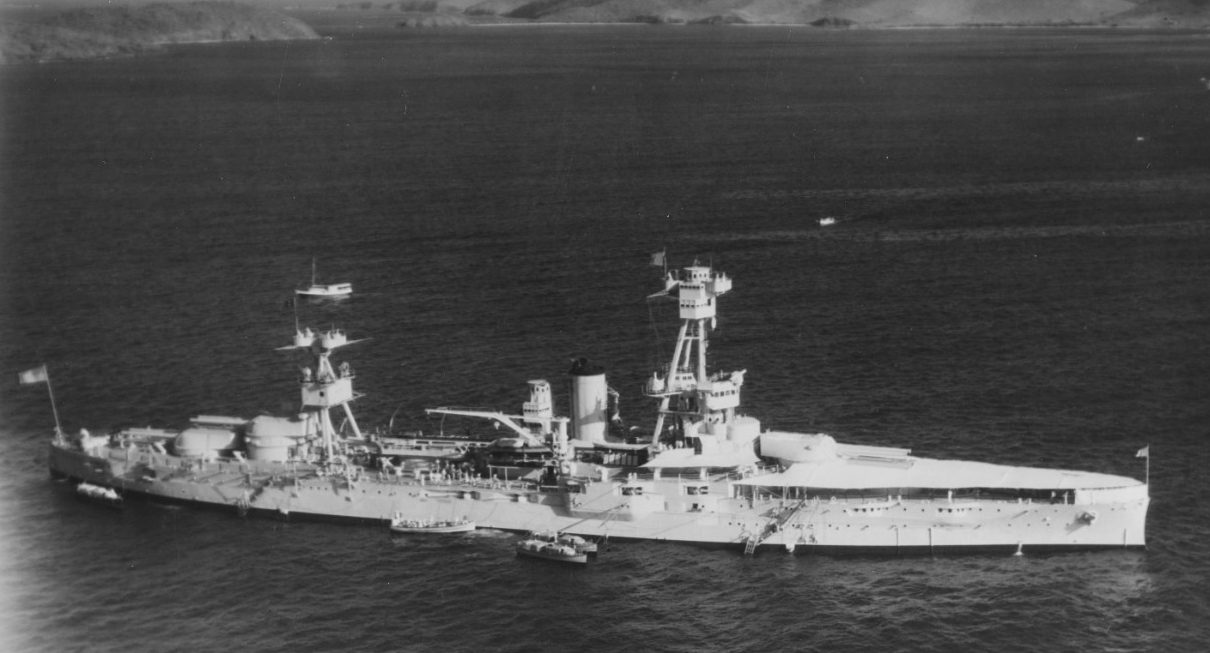
As in the previous year, New York’s got underway for winter training in the Caribbean in mid-January. Getting underway on 14 January 1939, she arrived in the Culebra area on the 19th. She operated here until 10 February. Moving to Fort-de-France, she arrived the next day and remained there until returning to Culebra on the 16th. From Culebra she got underway for a week at sea on 20 February. Returning on the 27th, she remained in the area until steaming to Norfolk on 13 March and reaching on the 18th. Remaining until 17 April, New York steamed to New York, arriving on the 22nd. Departing on 25 April, she shuttled between there and Norfolk until 18 May. Steaming up the Chesapeake from Norfolk to the Naval Academy on 25 May, she arrived later that same day to embark midshipmen for their summer cruise. Getting underway on 3 June, the battleship was enroute to Halifax, via Provincetown, Mass. (9-12 June). She reached Nova Scotia on 17 June. From Halifax, she went to sea then steamed up the St Lawrence River to Quebec City, Quebec, Canada, arriving on 10 July. After ten days, she steamed back down the St. Lawrence enroute to Portland, Maine, reaching on the 31st. Departing on 7 August, New York charted a course to Hampton Roads. Arriving on the 11th, she conducted exercises on the Southern Drill Grounds on the 14th and 17th. From the latter exercise, she headed to New York and arrived on 18 August. The battleship steamed out of the Verrazano Narrows on 24 August and reached Annapolis on the 28th. With the disembarkation of the midshipmen, she left on 30 August and after touching at Yorktown on the 31st, returned later that day to Hampton Roads; the following day [1 September], Germany invaded Poland. The ship then docked at the Norfolk Navy Yard on 18 September and underwent overhaul into December. Undocking and going to sea on 14 December, she returned to Norfolk on the 16th, and spent the holiday season in port.
New York continued her operational routine in 1940. Getting underway on 11 January from Norfolk, she headed to Culebra. Arriving on 15 January, she would operate from Culebra; Guantanamo; and Mayagüez, P.R., into March. Getting underway on 8 March, she returned to Norfolk on the 12th. She docked at the Navy Yard on 22 April and underwent maintenance until the 26th. With her yard work completed she remained at Norfolk until 30 May, when she again headed to Annapolis, so that she could embark midshipmen for another summer cruise. Getting underway from the Naval Academy on 8 June, New York set a course for Colon and arrived on 15 June. Visiting at Colon until the 20th, the battleship moved on to Laguaira, Venezuela (24-28 June) and St. Thomas (2-5 July). Steaming north from the Caribbean, she reached New York on 12 July. With time visiting New York (12-16 July), Newport (17-19 July), and Boston (20-23 July), the battleship steamed back to the Caribbean, reaching Guantanamo on the 29th. She departed Cuba on 9 August and returned to Annapolis on the 14th. Having disembarked the midshipmen, the ship left the next day and arrived at Norfolk. Two days later, on 17 August, she headed to New York. Reaching the next day, she remained until the 20th, then got underway to return to Guantanamo (24-28) and then to the Canal Zone (30 August-1 September). She then set a course to return to Norfolk and arrived on 7 September. Operating on the Southern Drill Grounds (9-12 September), she moved to New York (13-14 September) and back to Hampton Roads (15-27 September). She returned to New York on the 28th, and then departed bound for Guantanamo on 1 October. Arriving in Cuba on 5 October, she operated in the area until steaming to Colon on 10 October. After two days at Colon, she set a course for Norfolk on 14 October and reached the Navy Yard on the 19th. Docking until the 26th, she moved to Hampton Roads that same day. Leaving the next day, she arrived in New York and two days later on 30 October, set a course for Colon. After a two-day visit, she made her way via Guantanamo (9-10 November) back to Norfolk, arriving on the 14th. Getting underway again on 6 December, New York returned to Guantanamo for five days (10-15 December) before returning to Hampton Roads on the 18th. Later that day, she docked at the Norfolk Navy Yard and remained there for the holidays.
New York undocked on 3 January 1941. Departing Norfolk on 7 January, she steamed to Guantanamo and her regular routine of winter training in the Caribbean. Arriving on the 11th, she remained in the area until 20 January when headed to sea. Over the next seven weeks, New York conducted training and made visits to Culebra (22 January-14 February); Mayagüez (15-19 February), Charlotte Amalie, V.I. (19-24 February), and Fajardo, P.R. (24 February-10 March). With her departure on the 10th, she steamed to Norfolk and passed through the capes on 14 March and entered the Norfolk Navy Yard. After four days, she steamed out of the yard. Bound for Newport, she arrived on 19 May. Over the next few weeks, New York went to sea based from Newport. Standing out of Newport on 22 June, she headed to Argentia, Newfoundland, and arrived on the 27th. In company with Arkansas and the light cruisers Nashville (CL-43) and Brooklyn (CL-40), New York served as an escort for the convoy carrying the First Marine Brigade (Provisional). At 2200 on 1 July, the convoy departed Argentia bound for Iceland. On 6 July the convoy passed through the flotsam of HMS Hood sunk by the German battleship Bismarck in the Denmark Strait on 24 May. Arriving at Reykjavik, the Icelandic capital, on 7 July, the marines disembarked from the transports in order to relieve the British troops then occupying the island in order to keep it from falling into the hands of the Germans. With their escort mission completed, the battleships conducted a “Neutrality Patrol” in the North Atlantic, remaining at sea for seventeen days. Afterward, she returned to Argentia to serve along with Arkansas and Texas as the station ships to protect against any possible German action in the waters near the new U.S. base established there. New York was eventually sent to Norfolk to undergo an additional modernization to increase the range of her main batteries by increasing the maximum elevation of the guns from 15º to 30º. It was while she was undergoing this refit that the Japanese attacked Pearl Harbor on 7 December 1941 and the U.S. entered World War II.
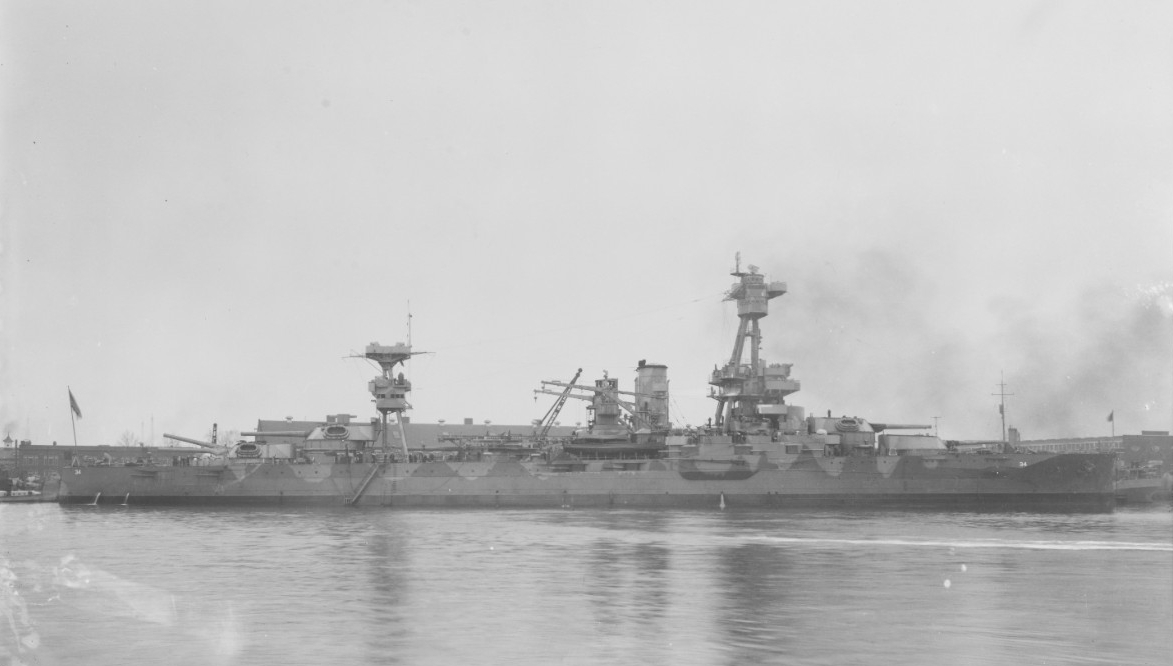
With her refit completed, New York steamed out of the Norfolk Navy Yard bound for Halifax. Arriving on 21 February 1942, she joined a task force in order escort a convoy to Iceland. The convoy reached Reykjavik Roads on 2 March. There were several U-boat contacts enroute which saw the dropping of depth charges with negative results. Having escorted another convoy enroute, New York returned to Norfolk on 27 March. Departing Norfolk on 24 April, she proceeded to Halifax, via New York (25 April), and arrived on 2 May. Again assigned to an Iceland-bound convoy, she proceeded to Argentia (5 May) and arrived in Iceland on the 10th. Having completed the mission, she returned to New York on 20 May. Again assigned to escort a convoy, she departed the next day for Halifax. Arriving on 2 June, she was assigned to escort a convoy of fast transports and tankers in company with a heavy cruiser and eleven destroyers. Reaching the Firth of Clyde, she dropped anchor at Greenock, Scotland, on 10 June. New York then received orders to return to the U.S., arriving back at Norfolk on 30 June. She entered the yard and underwent overhaul and additional modernization and modification of her ordnance. The secondary battery was reduced to six 5-inch guns and the anti-aircraft batteries were increased to ten 3-inch/50 caliber guns, 24 40 millimeter Bofors guns in quadruple mounts, and 42 20 millimeter Oerlikon guns. With her updated ordnance, New York got underway from Norfolk on 12 August. Arriving at New York the next day, she escorted another convoy, this time to Nova Scotia. After her arrival, she remained at Halifax until 22 August, when she got underway bound for the Firth of Clyde. Arriving on 31 August, she remained at Greenock until 5 September. Bound for the U.S., she arrived at Norfolk on 15 September. After her return, she made preparations to participate in Operation Torch, the invasion of Vichy French North Africa.
Assigned to the Southern Attack Group under Rear Adm. Lyal A. Davidson, in his flagship, Philadelphia, New York departed Norfolk on 23 October 1942. Screened by six destroyers screen, the battleship and light cruiser arrived at their objective, Safi, Morocco, on 7 November. At 0430 on the 8th, the Batterie des Passes at the entrance to Safi harbor opened fire on one of the destroyers. With orders to not fire until fired upon, New York, Philadelphia, and the destroyer Mervine (DD-489) commenced firing upon Batterie Railleuse in response. At 0500 three planes were catapulted from New York, on for anti-submarine patrol, the other two for spotting of rounds. While some of the battery’s 300 rounds straddled the battleship, none struck. One of New York’s 60 14-inch shells, however, ricocheted through the battery’s observation slit, destroying all within and silenced the Vichy guns. Rear Adm. Davidson noted in his report that the fire delivered by New York silenced the battery and effectively saved the destroyers Cole (DD-155) and Bernadou (DD-153) from severe damage from the French position. With the landing of the U.S. 9th Infantry Division's 47th Infantry Regiment at Safi, New York received orders to join Task Group (TG) 34.9 and shifted to Fedala [Mohammedia] on 10 November to assist the operations of the Center Attack Group. On the 11th, New York moved into position on the firing line to bombard forts off Casablanca. Those orders never came however. New York then returned to Fedala and anchored clear of the transports of TG 34.9. The battleship moved into the harbor and anchored. After sunset, searchlights from well inland lit up the ships at anchor and silhouetted them for submarines. Three transports were subsequently torpedoed; New York witnessed the attacks but was otherwise, unscathed. The next day, three additional ships were torpedoed and again she sustained no damage. Afterward, the battleship saw no significant action and returned to Norfolk on the 23rd.
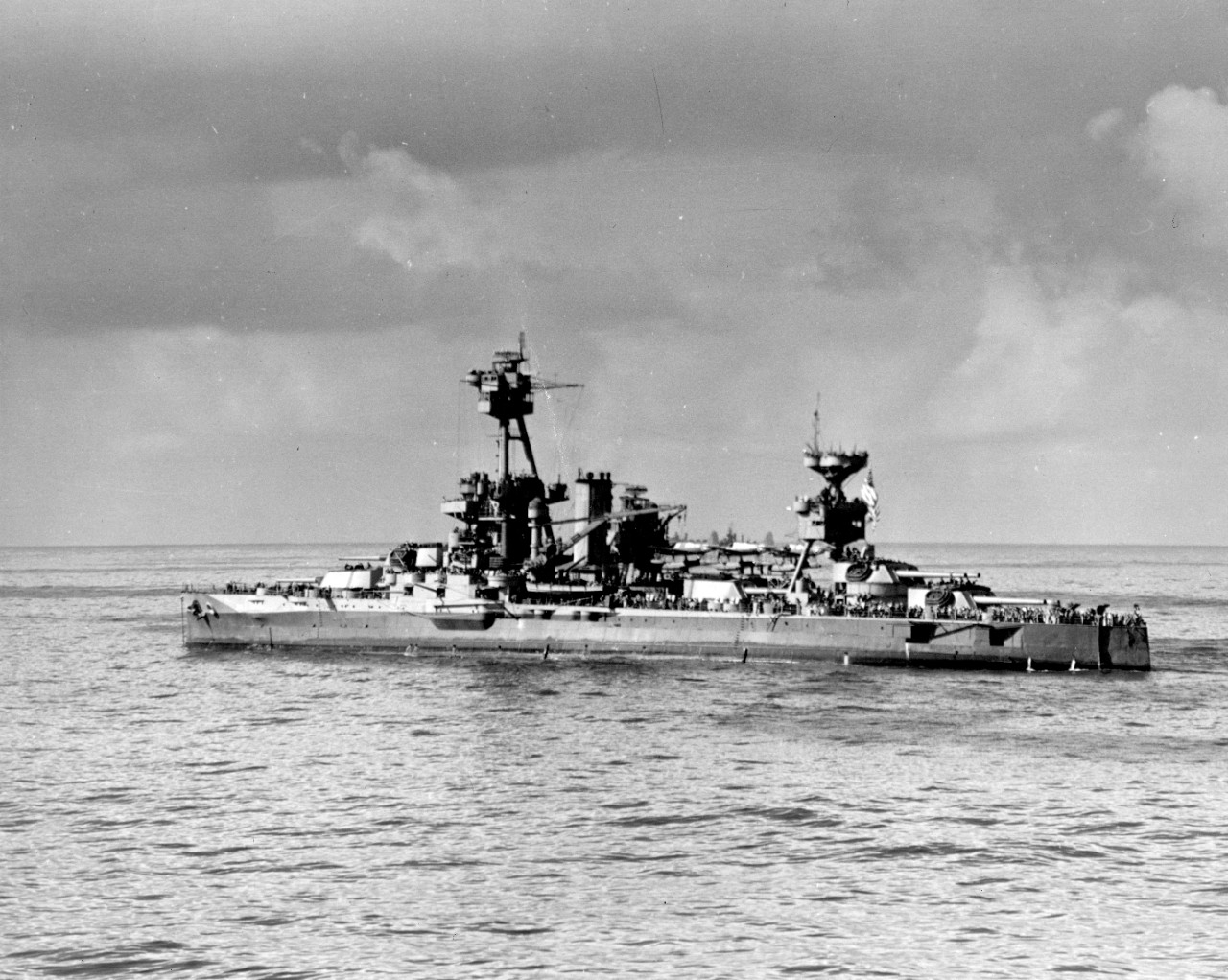
With her duties in support of the Torch landings completed, New York returned to convoy duty. Departing Norfolk on 24 November 1942, she moved to New York (25 November-12 December) and then escorted a convoy across the Atlantic to Casablanca (24-29 December) and returned to Norfolk on 12 January 1943. Departing Norfolk again on 26 February, she again moved to New York (27 February-5 March) and escorted a second convoy to Casablanca. Arriving in Morocco on 18 March, she remained until the 25th. Returning to New York (5 April-1 May), she was selected to refit in order to serve as a main battery and escort training center. Leaving New York, she arrived at Portland, Maine, on 2 May she remained there until 27 July. During this final refit her anti-aircraft battery was increased to ten 3-inch/50 caliber guns, forty 40 millimeter Bofors and thirty-six 20 millimeter Oerlikons. Her fire control systems were also improved and her displacement increased with the burgeoning of her armament. With her yard work completed, she departed Portland and returned to Norfolk on 2 August. She then took up important duty training gunners for battleships and destroyer escorts in Chesapeake Bay, rendering this vital service until 10 June 1944. Between August 1943 and June 1944 about 11,000 enlisted men and 750 officers from the Navy, Coast Guard, and Allied navies trained on her. Afterward, she conducted three consecutive midshipmen cruises from Annapolis to Trinidad in the British West Indies from 11 June to 31 August.
Selected to resume combat operations, New York weighed anchor on 21 November 1944 for a return to the West Coast. Transiting the Panama Canal on the 27th, “The Old Lady” arrived at San Pedro on 6 December. She spent the next thirty-four days conducting gunnery training off San Clemente in preparation for amphibious operations in the final drive toward the Japanese home islands.
New York departed San Pedro on 12 January 1945, she made a visit to Pearl Harbor enroute to refuel and rearm. Departing bound for Ulithi to join the other heavy units of the Pacific Fleet, then forming for the assault on Iwo Jima in the Bonin Island chain. Enroute she lost a blade from her port screw limiting her maximum speed to thirteen knots. Forced to leave the task group with which she was steaming, Idaho (BB-42) and Arkansas, she headed for Eniwetok to survey the damage and await further orders. With her screw still damaged, she left Eniwetok after a two-day stay and proceeded directly to Saipan, Marianas, to rendezvous with Idaho, Tennessee (BB-43), Nevada (BB-36), Texas, and Arkansas. Upon her arrival, she joined the Iwo Jima assault force in rehearsals. Steaming well ahead of the main body, she joined with Task Force (TF) 54 in pre-invasion bombardment of Iwo Jima on 16 February. During the next three days, she fired more rounds than any other ship present. She also made the most spectacular shot of the bombardment with a 14-inch direct hit on an enemy ammunition dump. With the initiation of the landings, New York withdrew from the firing line to repair her damaged screw.
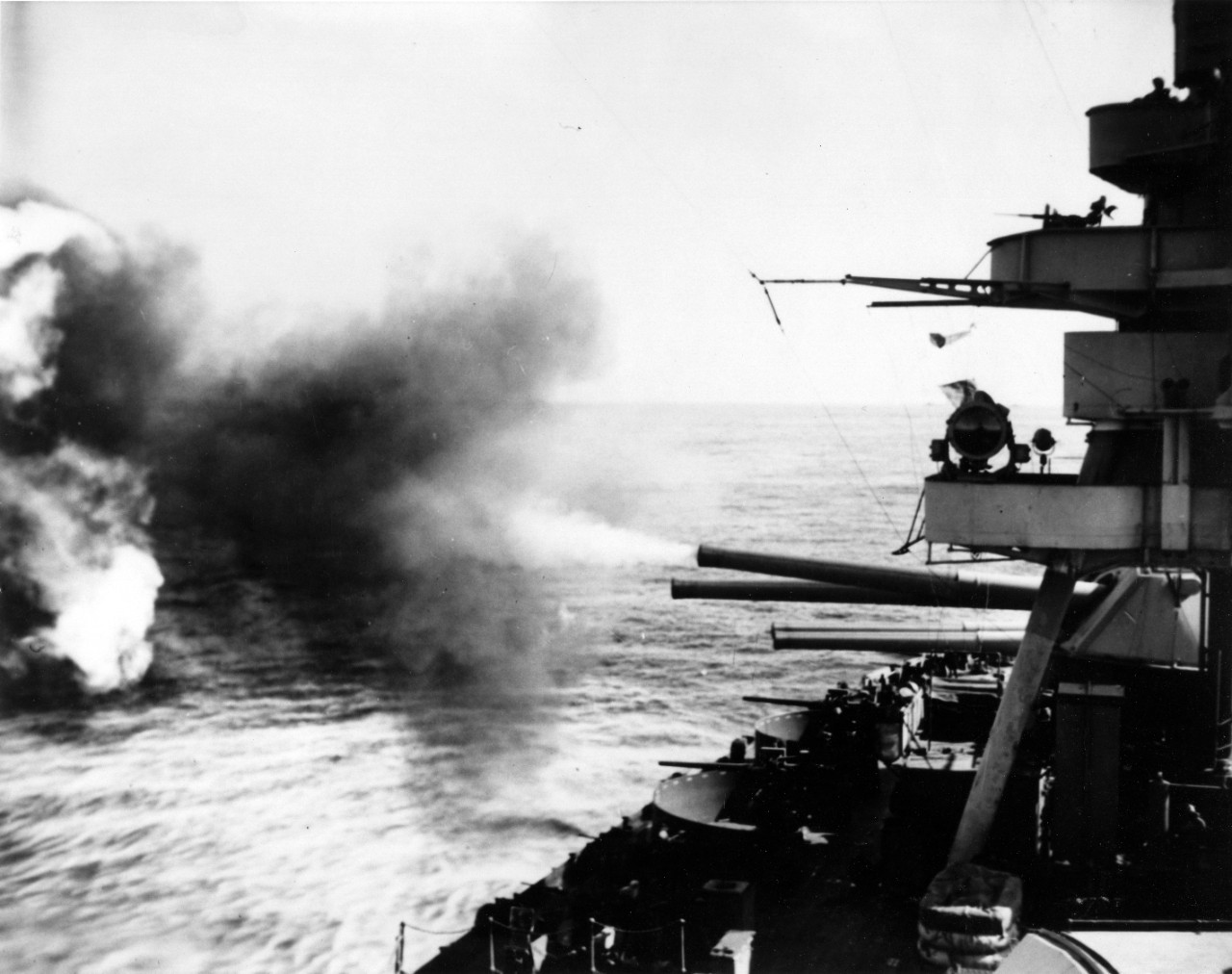
Clearing Iwo Jima, New York moved to Manus Island, Admiralty Islands [Papua New Guinea], where she underwent repairs for three weeks. With her speed restored, she departed Manus and arrived at Okinawa in the Ryukyu Islands and re-joined TF 54 on 27 March 1945. With her arrival in support of Operation Iceberg, she commenced 76 consecutive days of action. She participated in the pre-invasion bombardment, covered the landings in front of Yontan Airfield, and provided close naval gunfire support (NGFS) for the advance of the U.S. Tenth Army and the Marine III Amphibious Corps throughout the campaign. The 96th Division engaged in a furious assault on a Japanese position anchored at the west by a series of ridges just south of the towns of Kakazu and Machinato on 7-8 April. New York provided withering 14-inch and 5-inch NGFS in such rapid progression that the paint on the 5-inch guns blistered. The fire control officer ashore stated that the fire caused the Japanese to evacuate their positions and effectively neutralized the area. After providing further NGFS to the 24th Army Corps from the west, destruction fire by day and harassing fire by night, the battleship shifted to the Eastern Bombardment Group on 13 April to provide NGFS from inside Buckner Bay as the Tenth Army redeployed in preparation for an all-out assault on the Japanese positions around Kakazu and Machinato. New York did not go unscathed, however. A kamikaze aircraft demolished her spotting plane on its catapult and then crashed into the sea 50 yards beyond on 14 April. Over the next five days, she helped pound a path for the advance and repelling Japanese counterattacks. She hit the eastern flank of the enemy line at Conical Hill, scoring sixteen direct hits with her 14-inch shells on enemy fortifications.
Having played an important role in the Tenth Army’s advance, New York moved south and east on 19 April 1945, to join the fast battleships of TF 58. The task force’s mission was to divert enemy attention from the offensive with one of the heaviest bombardments ever made in support of amphibious troops which were making demonstration landings on southeastern beaches. Operating from the East China Sea, New York bombarded from the west in support of bitter fighting by the 27th Infantry Division east of the Machinato airfields and on the approaches to Naha and Shuri. During the night on 20 April, she answered friendly calls for help by lobbing in 5-inch star shells for illumination to counter the attempted Japanese infiltration of the lines. For three days, she battered Sugarloaf Hill, while units of the 24th Army took Hill 178, supporting the maneuver with neutralizing fires against the Japanese positions on Hill 187, scoring twelve direct hits. Given her fire support the troops ashore, sent New York a note of their appreciation on 24 April. As the newly-deployed First Marines advanced slowly in the west toward Naha and the 24th Corps encountered intense opposition around Shuri, New York shelled strong enemy positions on high ground. She contributed to heavy Japanese casualties and softened enemy defenses by hitting their eastern strongpoint of Yonabaru with 357 tons of 14-inch shells. She then maneuvered to assist the final assaults against Shuri. Supporting “The Old Breed” of the First Marine Division, 25-27 May, she played a major role in the annihilation of the enemy as they evacuated Shuri. New York followed this, in the first days of June, by supporting the landings of the Sixth Marine Division on the Naha Peninsula on 4 June and remained in their close support against the remaining Japanese resistance around Naha airfield. On 7 June, New York continued her battering of the Japanese firing on retreating troops north of Itoman. Having fired so many rounds in support of forces ashore, New York left Okinawa on 11 June to re-gun at Pearl Harbor. As she departed, Vice Adm. Harry W. Hill, Commander Amphibious Group Two, Fifth Amphibious Force remarked: “Your departure would bring comfort to a lot of Japanese were they alive to know of it. Your accurate gunfire and your aggressive spirit have done much to speed this campaign. Saw you do the same thing 28 years ago in the North Sea. Well done!”
New York steamed by way of Ulithi and Eniwetok to Pearl Harbor, where she was completely re-gunned in preparation for Operation Olympic, the planned invasion of Japan. The dropping of the atomic bombs (on Hiroshima on 6 August and Nagasaki on the 9th) and Japan’s subsequent surrender on 15 August 1945, precluded those operations.
With peace, New York departed Pearl Harbor on 3 September 1945, with 875 war veterans embarked. These passengers were put ashore at Los Angeles, Calif., on 9 September. After a week’s visit, she got underway again bound for a return to Pearl Harbor on the 16th, with 880 replacements. She then steamed from Pearl Harbor again on 29 September with passengers for New York, reaching on 19 October. She celebrated Navy Day on 27 October in the North River along with Missouri (BB-63) and Enterprise (CV-6).
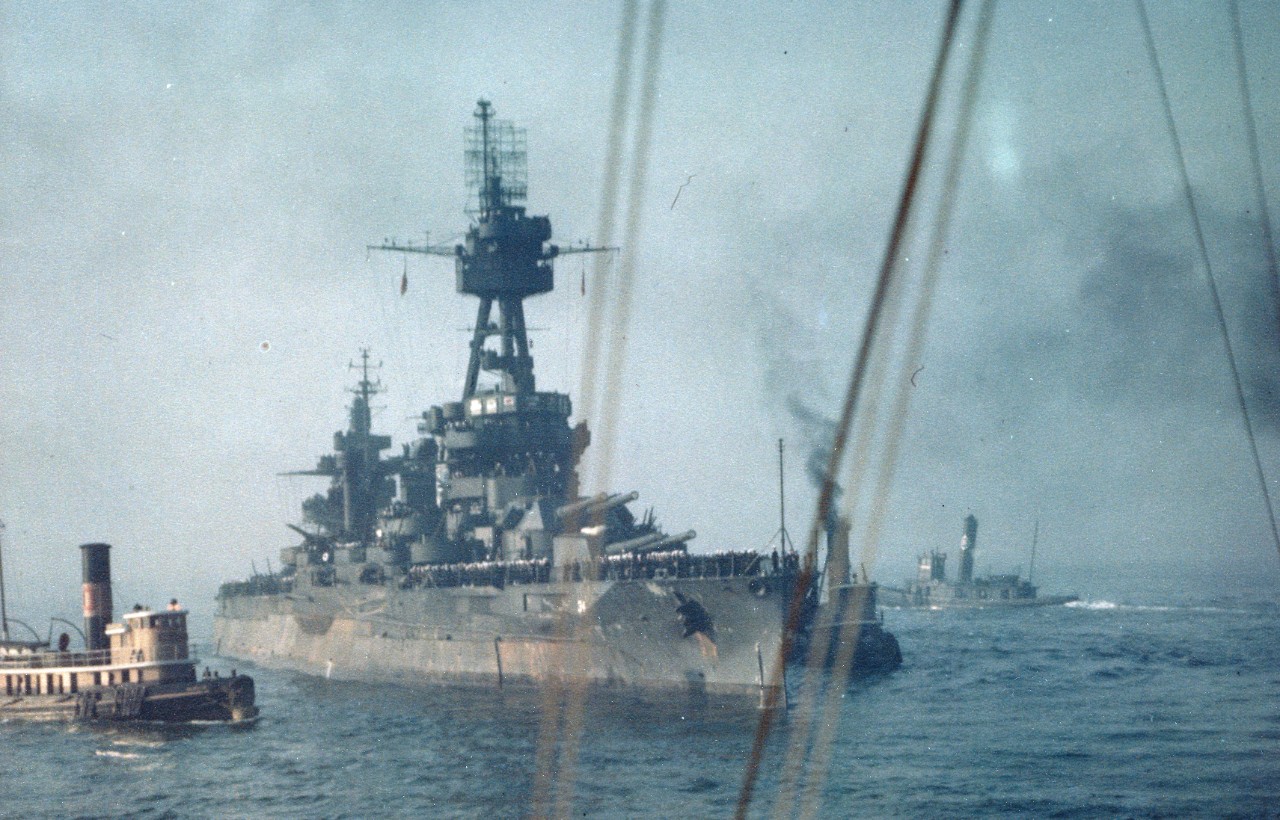
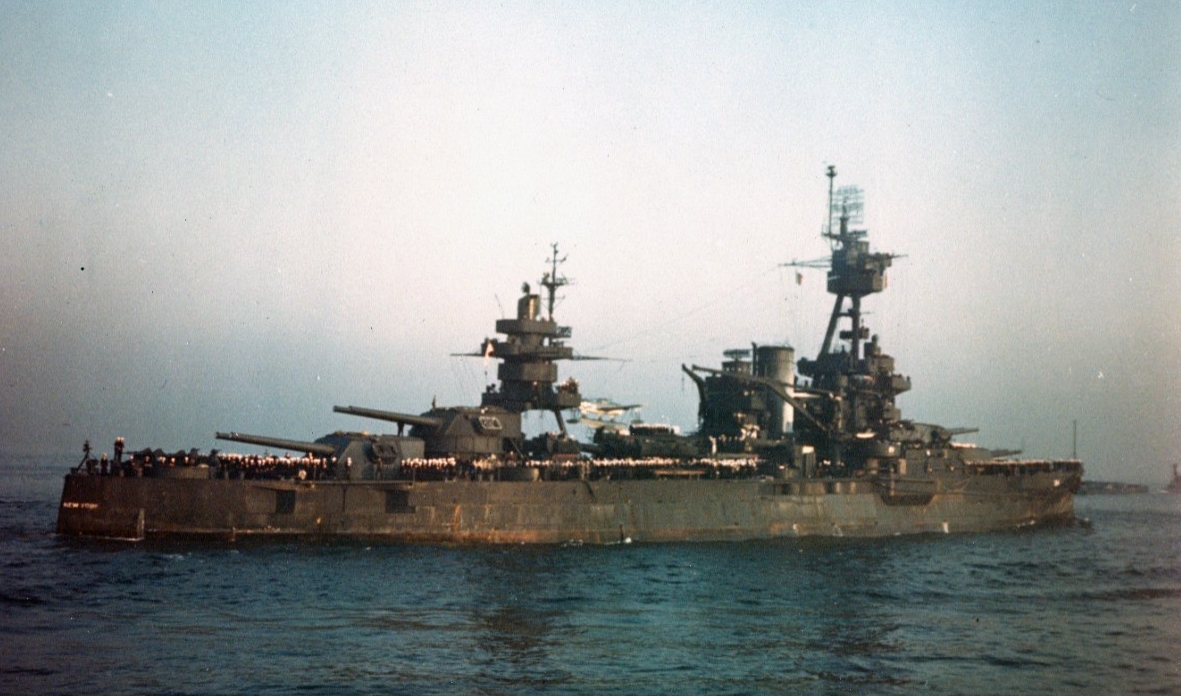
While at New York, the battleship prepared to serve as a target ship in Operation Crossroads, the atomic tests at Bikini atoll, Marshall Islands. Standing out of New York for the last time, on 4 March 1946, she set a course for a return to the West Coast. She left San Francisco on 1 May, and after calls at Pearl Harbor and Kwajalein, New York reached Bikini and anchored in the lagoon on 15 June. Just over two weeks later, on 30 June, the crew was evacuated to Rockbridge (APA-228) which departed the lagoon to take up station for the first test detonation --Test Able.
With her crew embarked on Rockbridge, 21 miles distant, New York was located 1,500 yards from ground zero on 1 July 1946. The air blast caused moderate to major physical damage, but she remained afloat. As the blast was determined to have caused only minimal radiological contamination, Rockbridge returned to the lagoon. The next day an initial boarding party returned to New York. By the next morning the entire remaining crew re-boarded. The crew was subsequently removed on 24 July, in advance of the second test. This second detonation--Test Baker--an underwater blast, on 25 July, was determined to have been more devastating to the target ships with greater radiological contamination. After several tests prior, Capt. Lowe Bibby, the commanding officer, and an initial work team returned to the ship on 5 August and began decontamination. After additional tests over the intervening days, New York was finally taken under tow by Achomawi (ATF-148) on 22 August bound for Kwajalein. The ships arrived on the 24th, and on 29 August 1946, New York was decommissioned.
Later towed to Pearl Harbor, New York was studied during the next two years. The venerable battle wagon was towed some 40 miles out to sea and on 8 July 1948, after an 8-hour pounding by ships and planes carrying out full-scale battle maneuvers with new weapons, “The Old Lady” slipped beneath the waves to her final resting place.
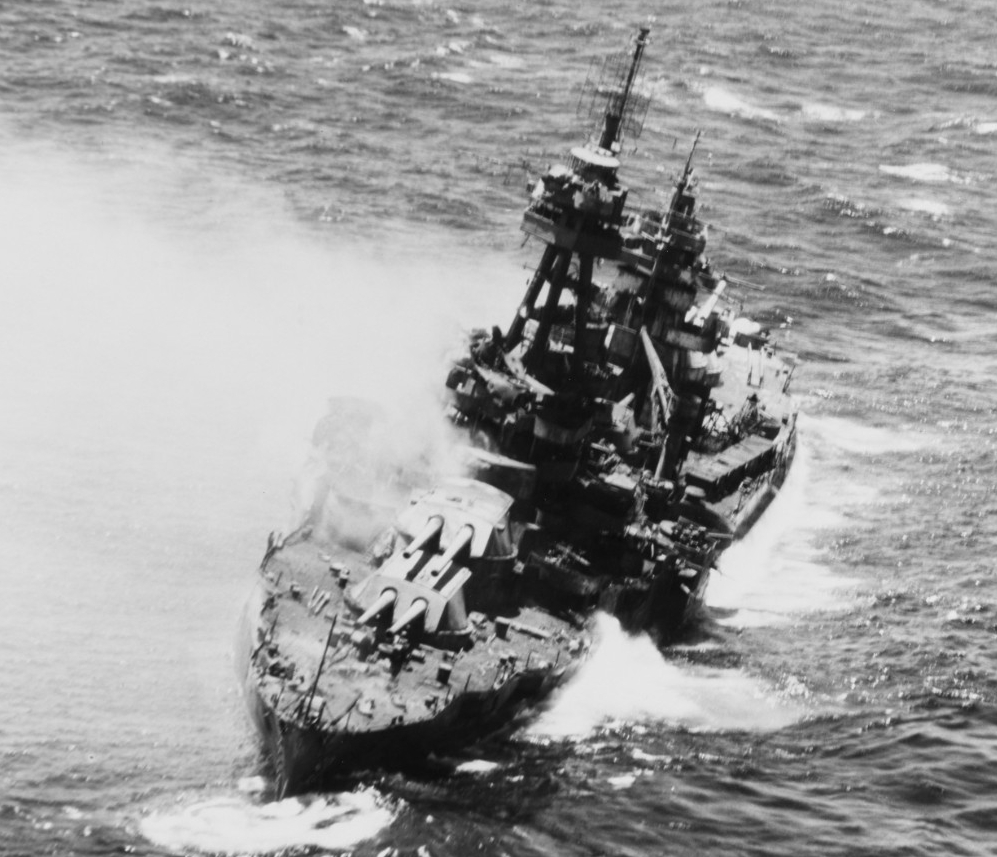
New York received three battle stars for her World War II service.
| Commanding Officers | Dates of Command |
| Capt. Thomas S. Rodgers | 15 April 1914 – 18 October 1915 |
| Capt. Hugh Rodman | 18 October 1915 – 21 October 1916 |
| Capt. Charles F. Hughes | 21 October 1916 – 1 October 1918 |
| Capt. Edward L. Beach Sr. | 1 October 1918 – 22 January 1919 |
| Capt. William V. Pratt | 22 January 1919 – 18 November 1920 |
| Capt. Ernest L. Bennett | 18 November 1920 – 29 November 1921 |
| Capt. Alfred W. Hinds | 29 November 1921 – 14 March 1923 |
| Capt. Roscoe C. Moody | 14 March 1923 – 22 March 1924 |
| Capt. Herbert F. Leary | 22 March 1924 – 26 May 1924 |
| Capt. David W. Todd | 26 May 1924 – 1 September 1924 |
| Capt. David E. Theleen | 1 September 1924 – 1 June 1926 |
| Capt. Clarence A. Abele | 1 June 1926 – 7 September 1928 |
| Capt. Sinclair Gannon | 7 September 1928 – 14 June 1929 |
| Capt. Edward S. Jackson | 14 June 1929 – 22 June 1931 |
| Capt. George F. Neal | 22 June 1931 – 24 May 1933 |
| Capt. Husband E. Kimmel | 24 May 1933 – 14 June 1934 |
| Capt. John S. Abbott | 14 June 1934 – 14 December 1935 |
| Capt. Leo F. Welch | 14 December 1935 – 1 June 1937 |
| Capt. Guy E. Davis | 1 June 1937 – 17 December 1938 |
| Capt. Robert M. Griffin | 17 December 1938 – 30 May 1940 |
| Capt. Daniel E. Barbey | 30 May 1940 – 2 January 1941 |
| Capt. James G. Ware | 2 January 1941 – 29 January 1942 |
| Capt. Scott Umsted | 29 January 1942 – 3 June 1943 |
| Capt. Kemp C. Christian | 3 June 1943 – 3 July 1945 |
| Capt. Grayson B. Carter | 3 July 1945 – 9 January 1946 |
| Cmdr. George L. Hansen | 9 January 1946 – 21 January 1946 |
| Capt. Lowe H. Bibby | 21 January 1946 – 3 August 1946 |
| Cmdr. Robert J. Connell | 3 August 1946 – 28 August 1946 |
Christopher B. Havern Sr.
8 September 2017


